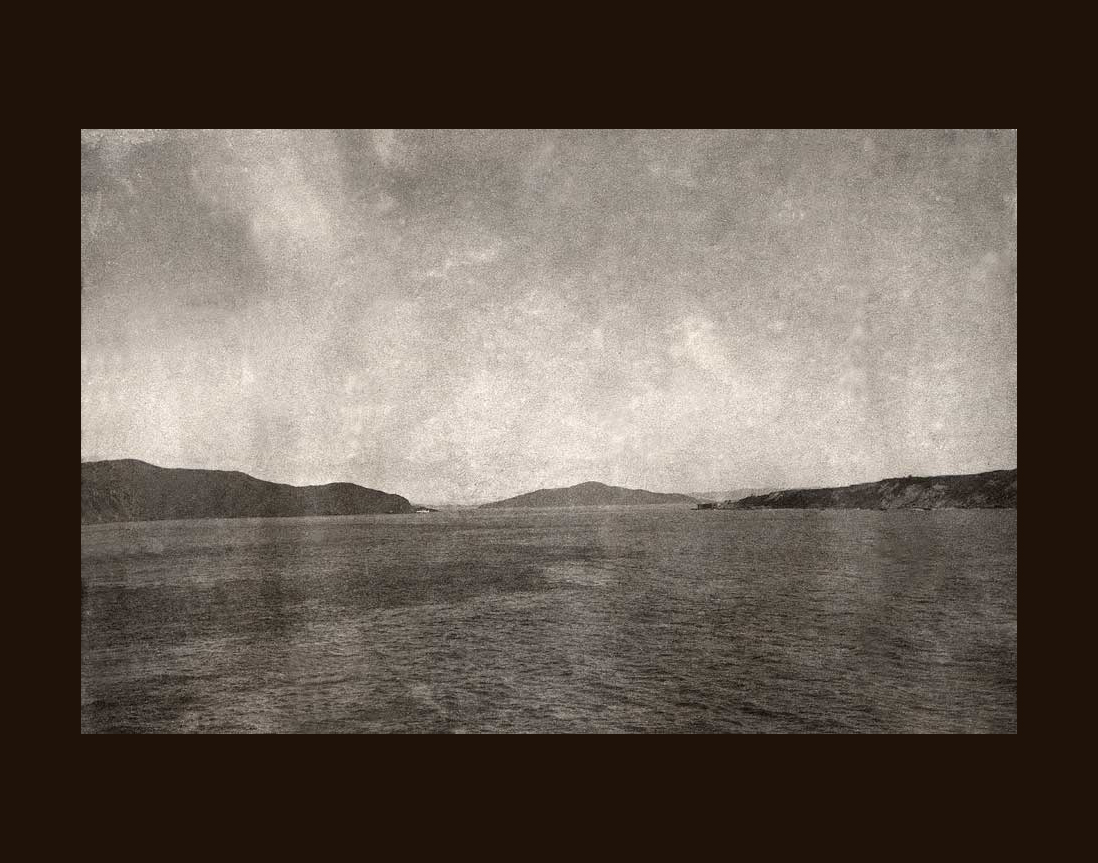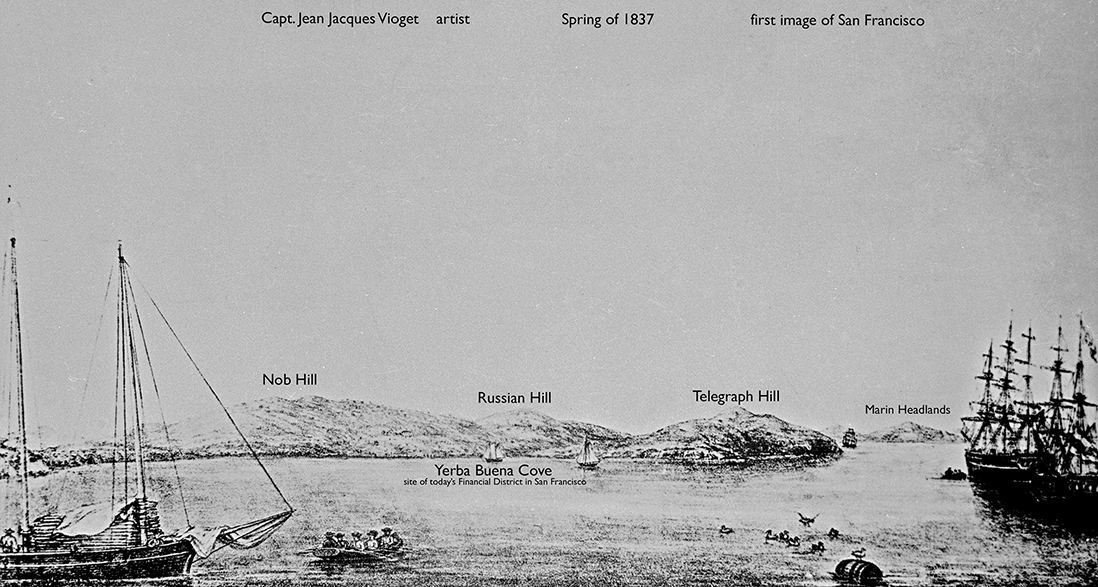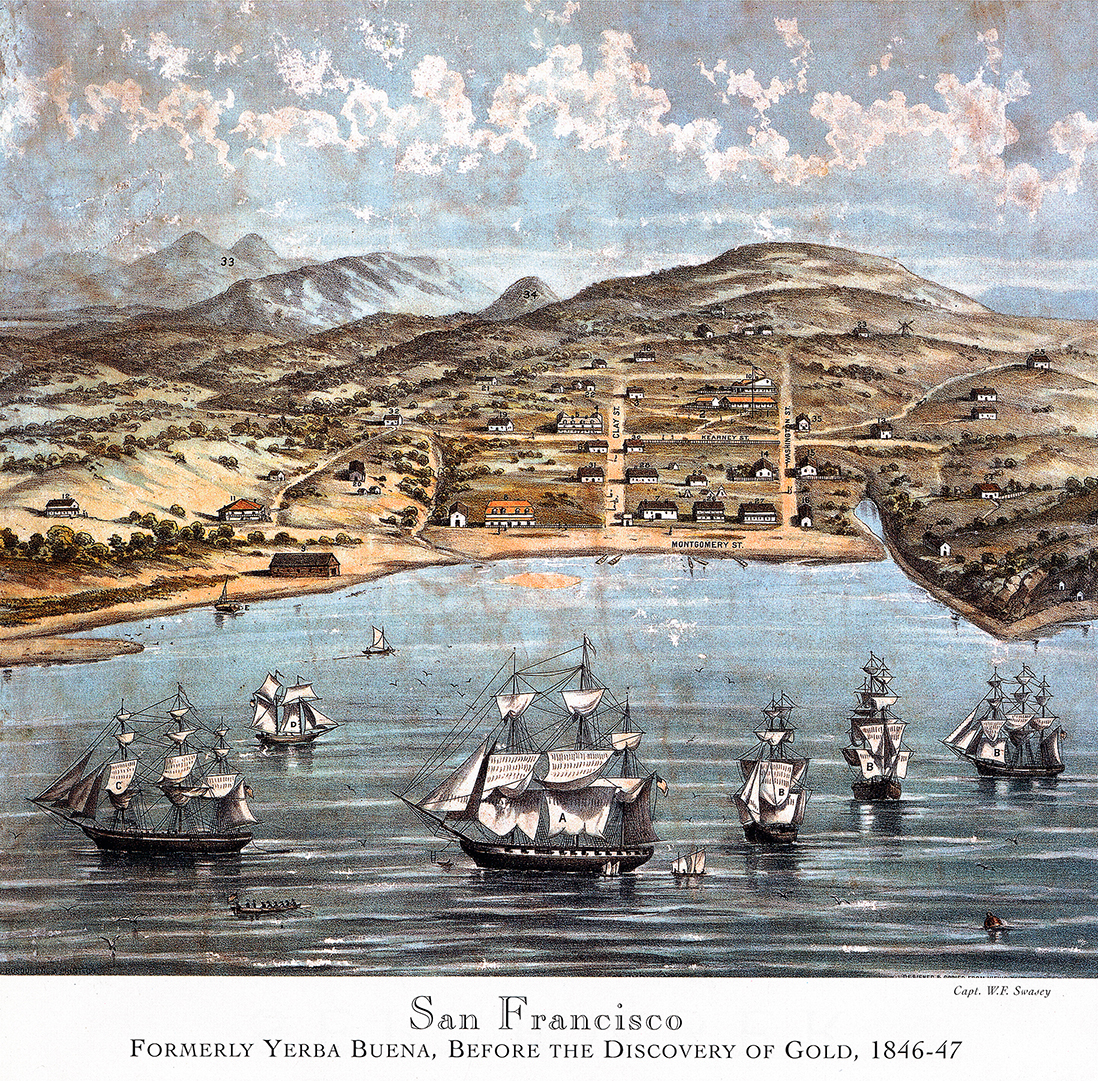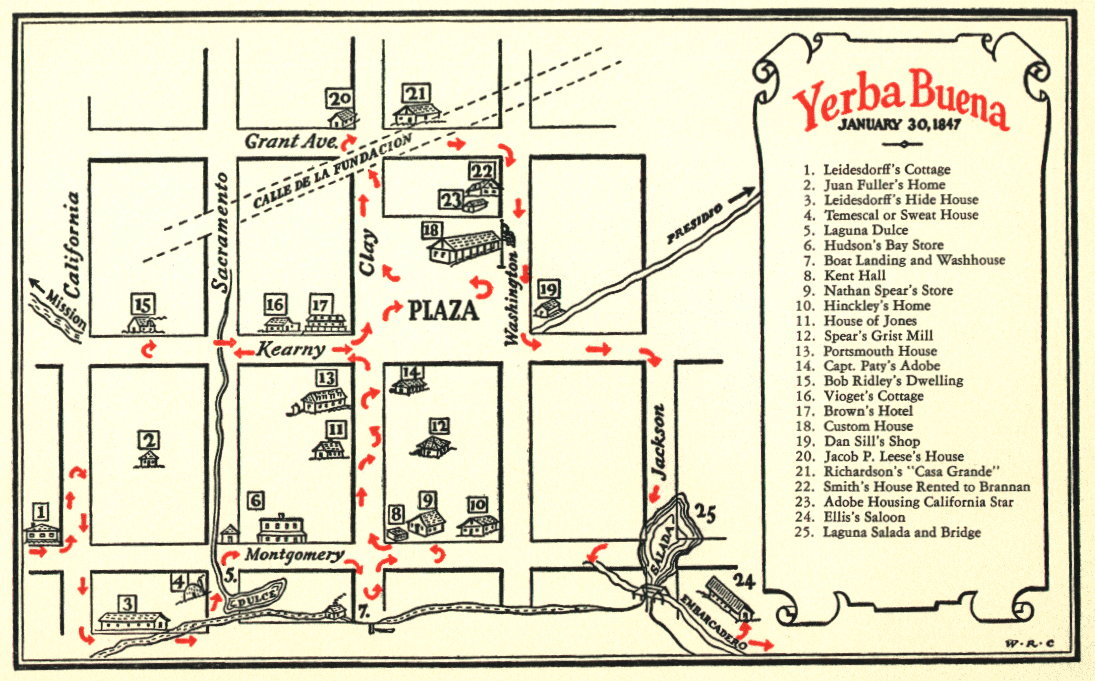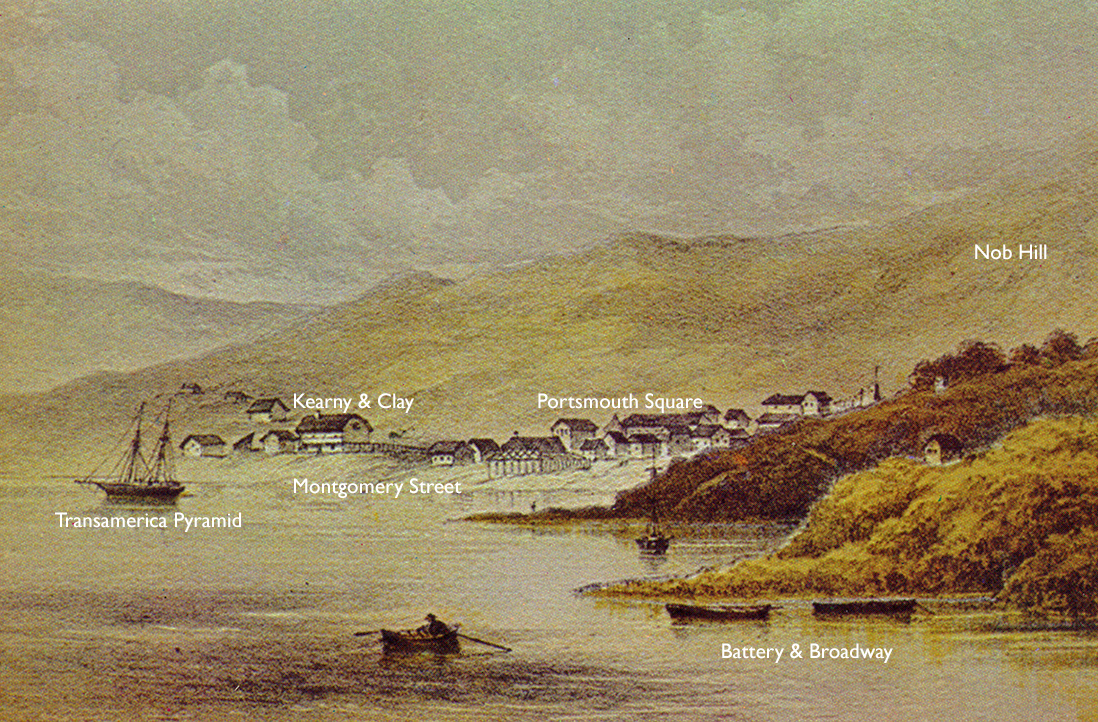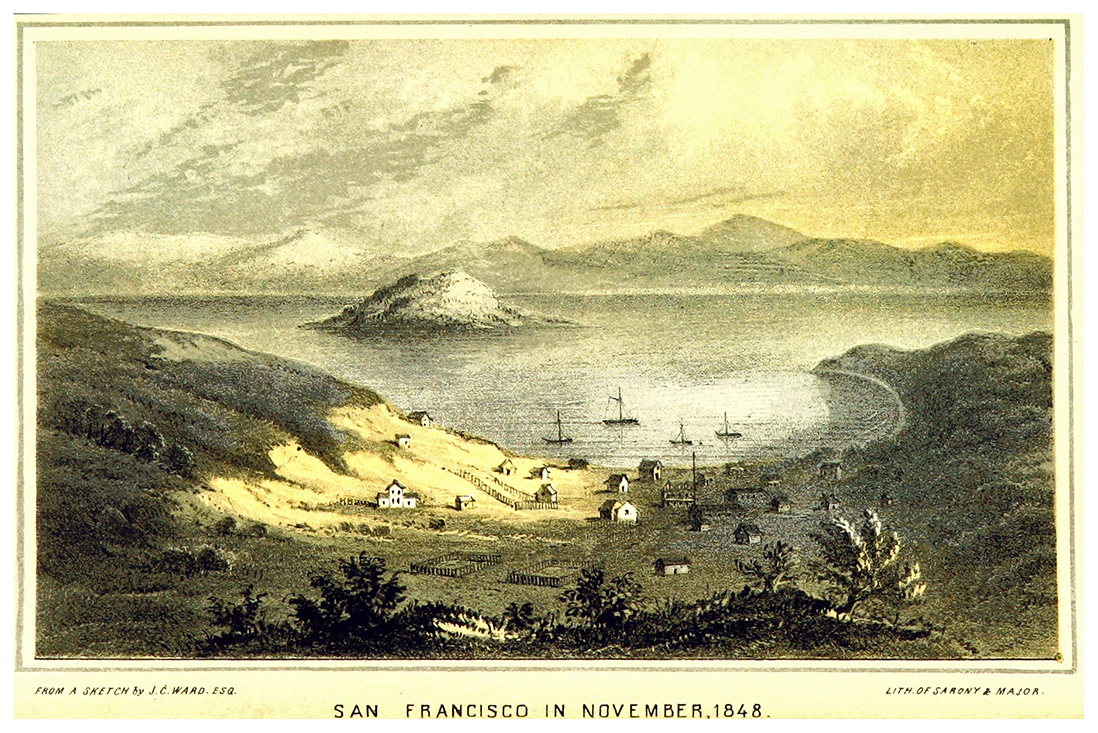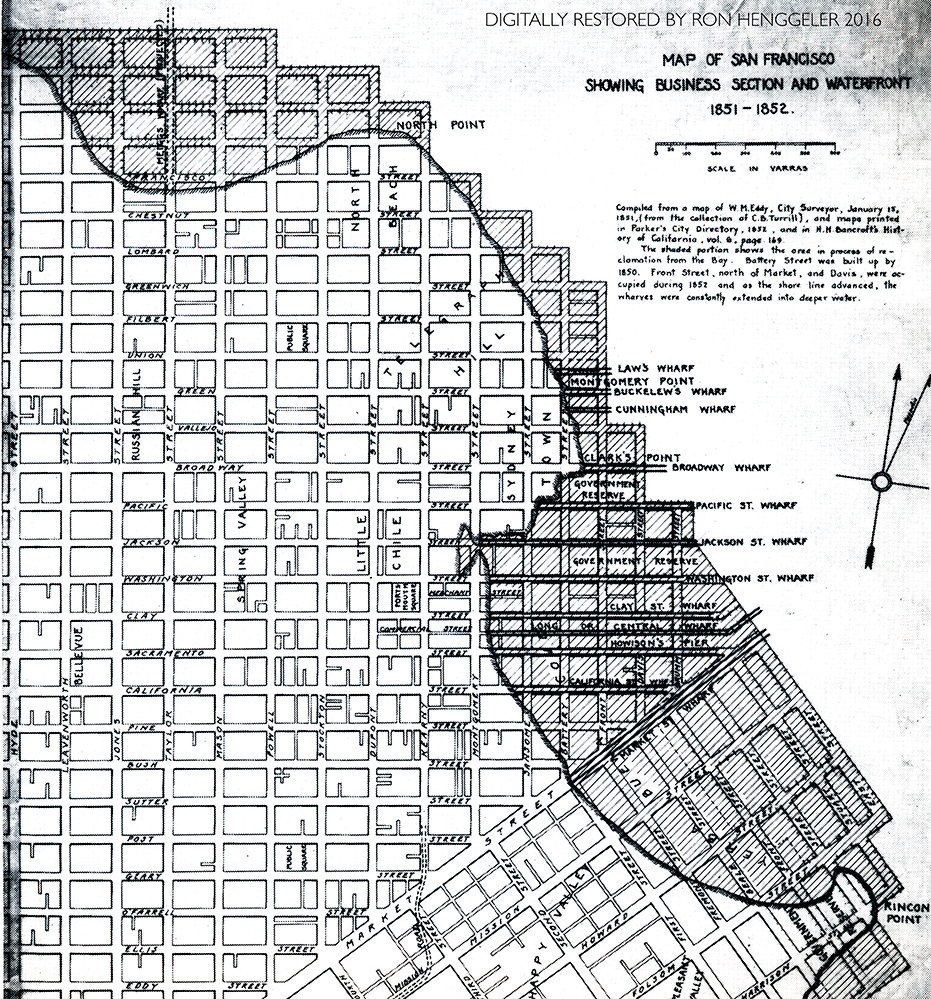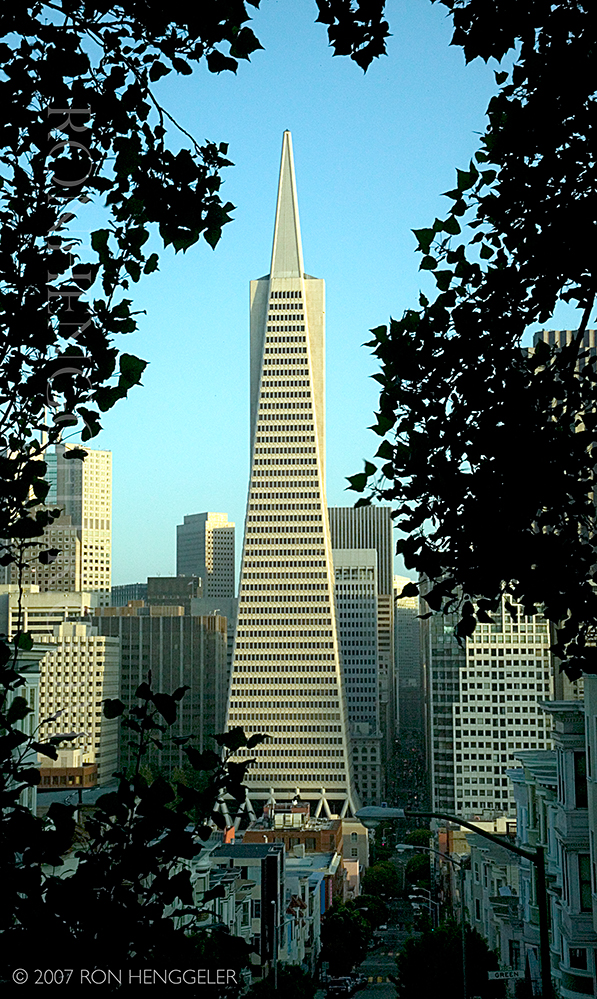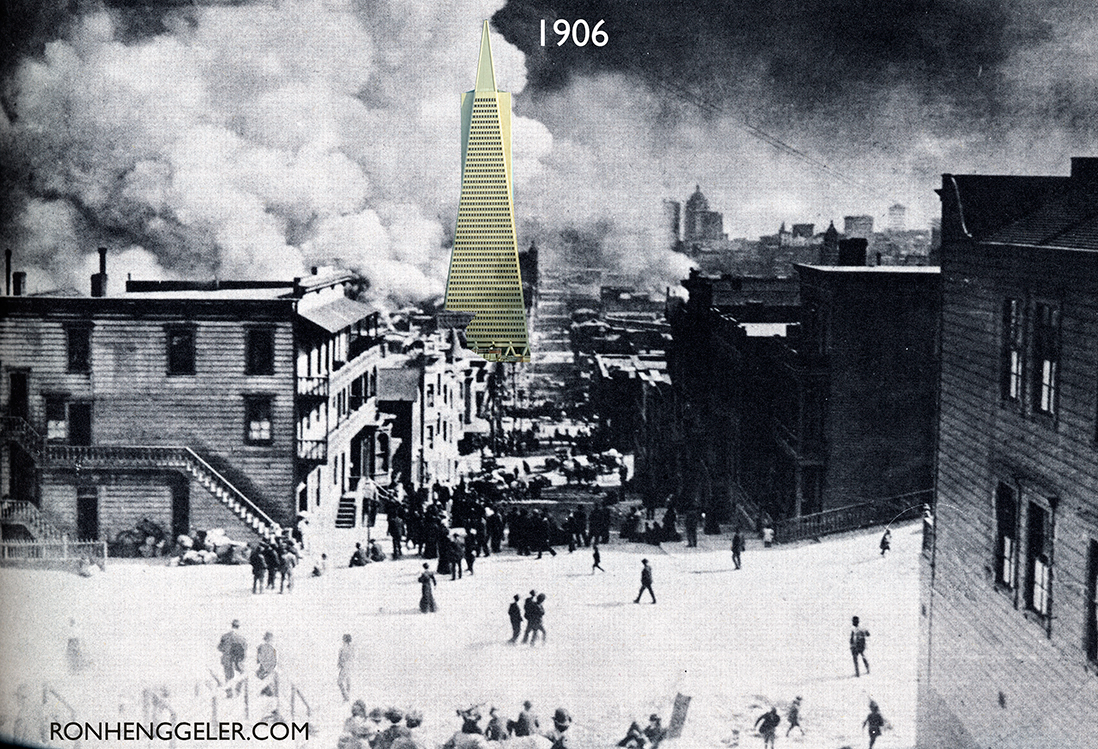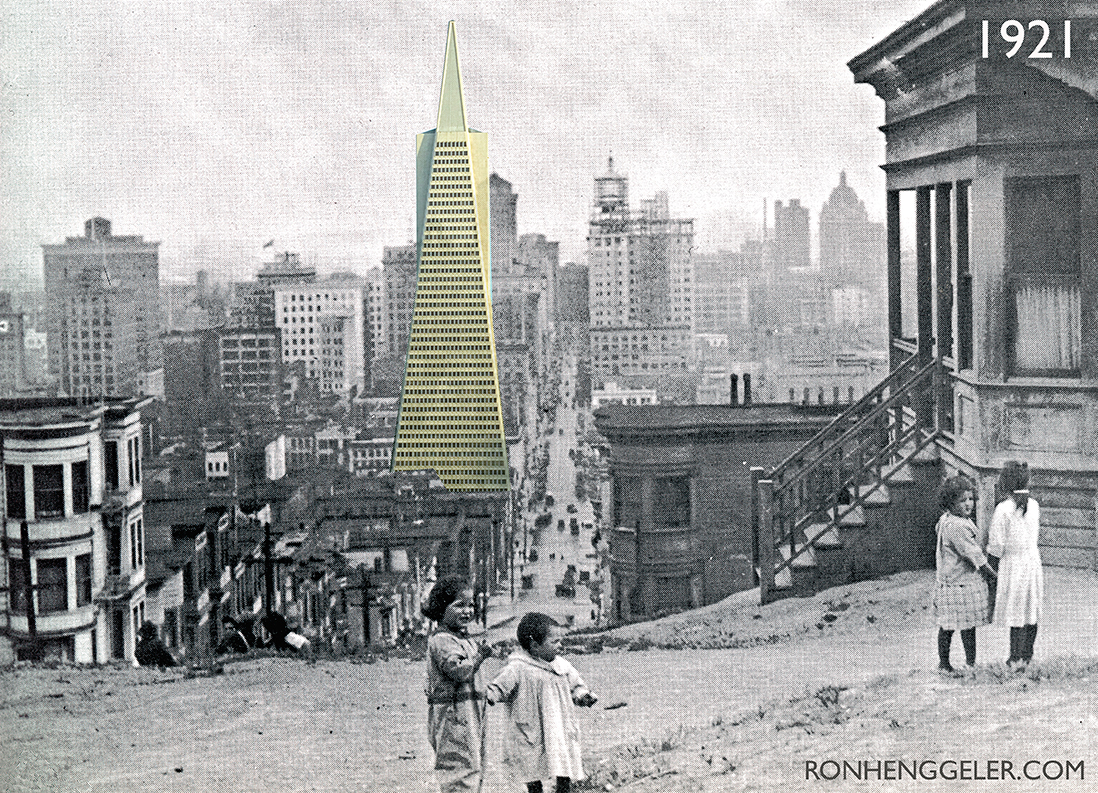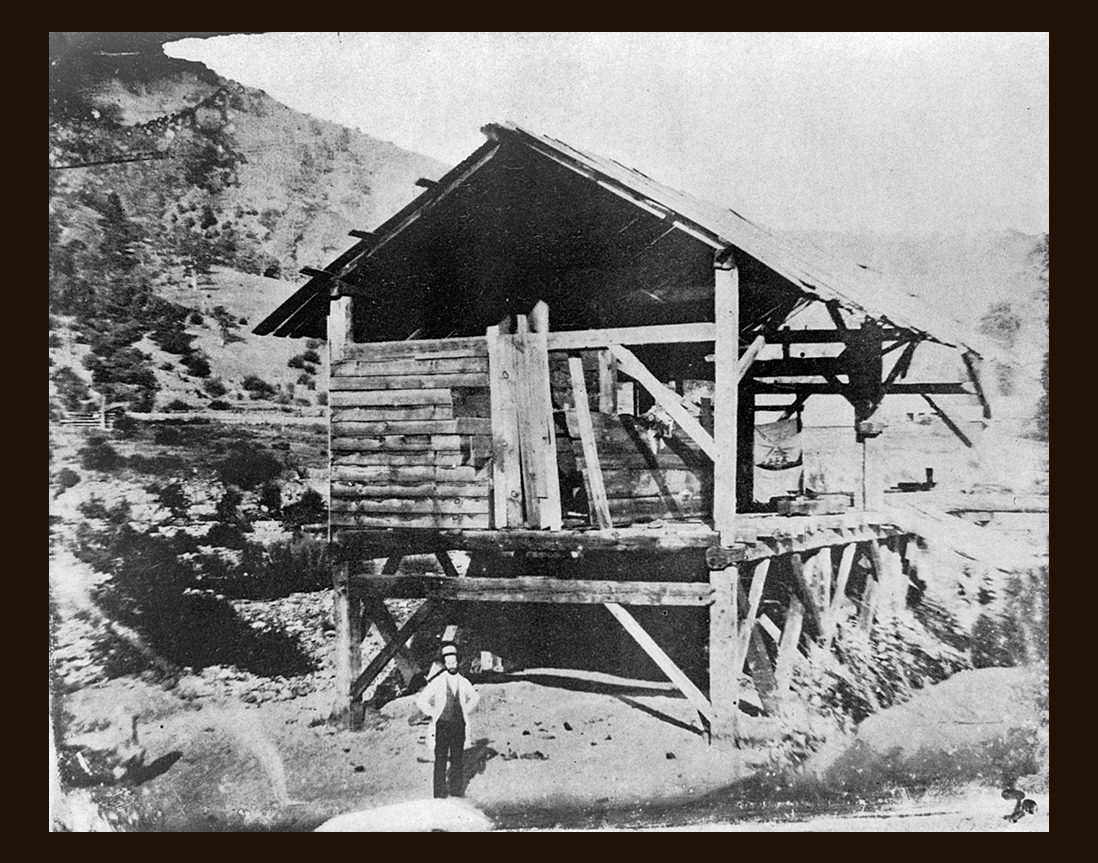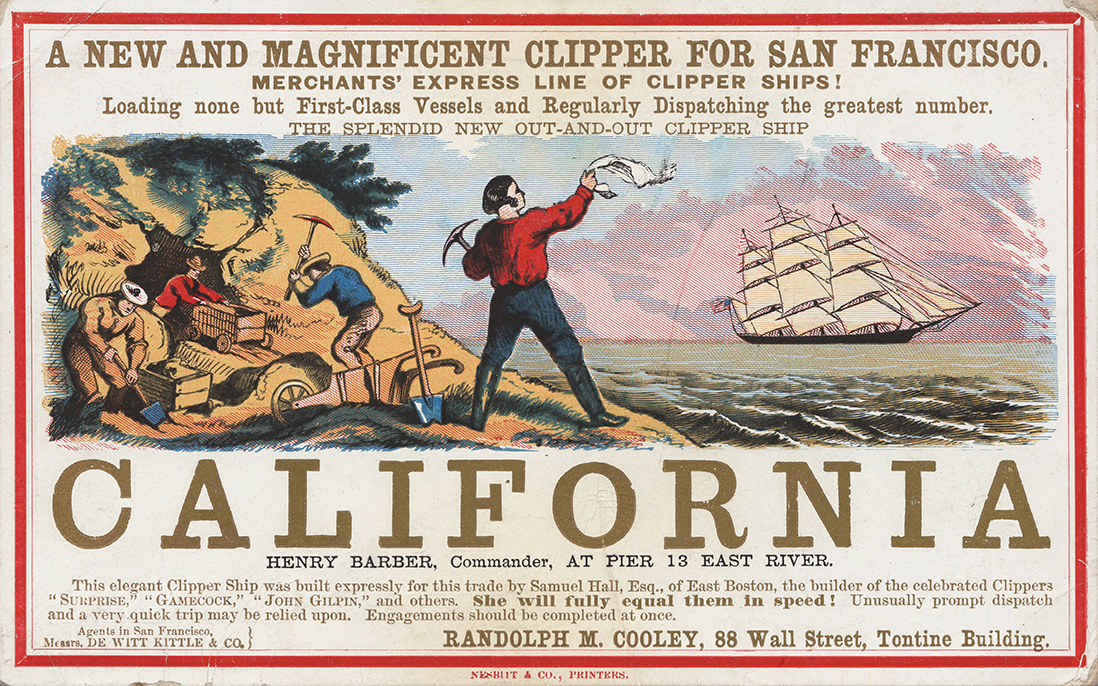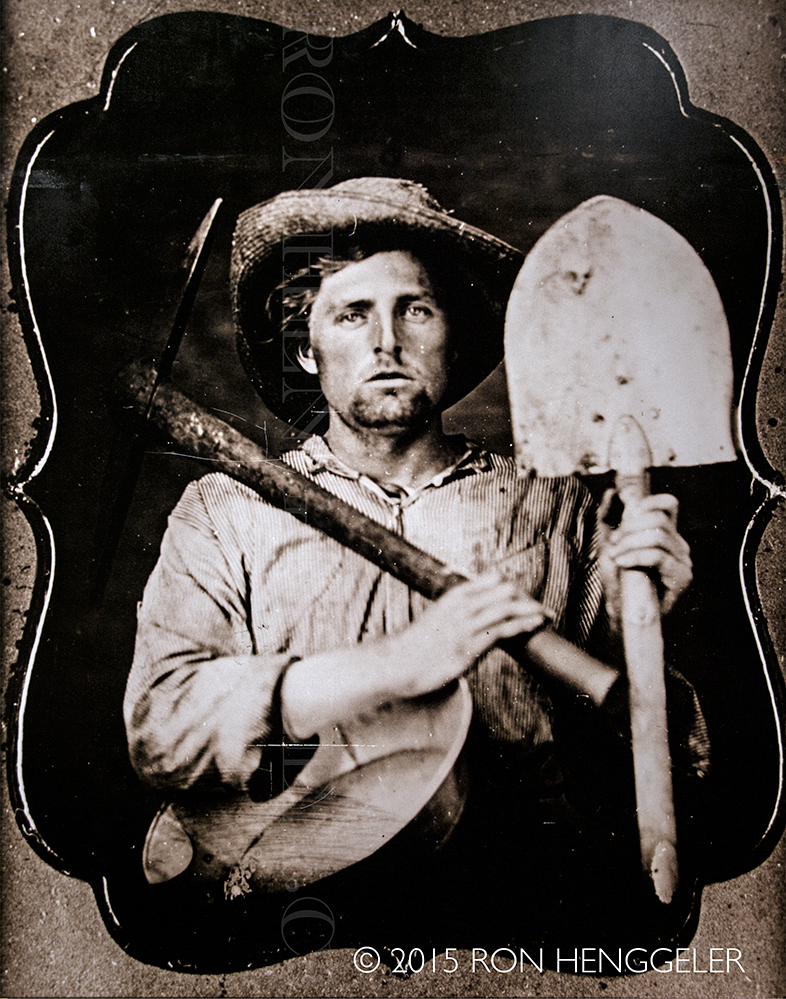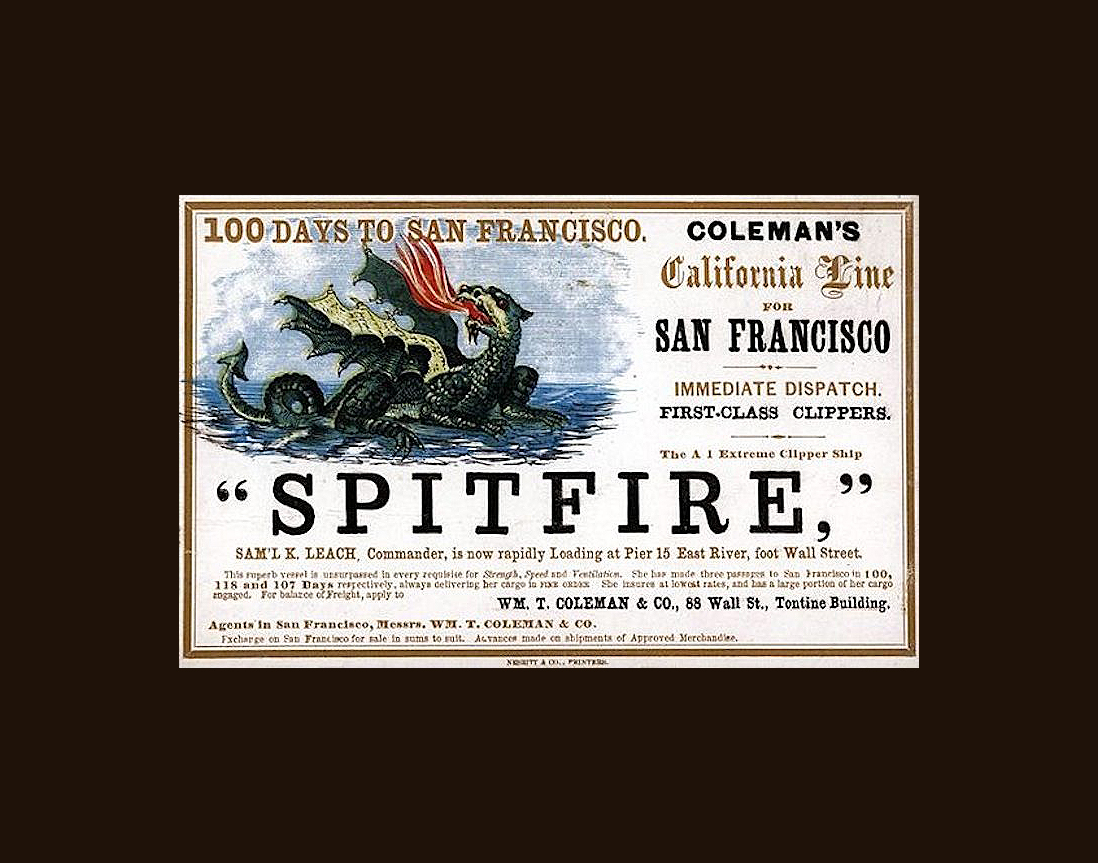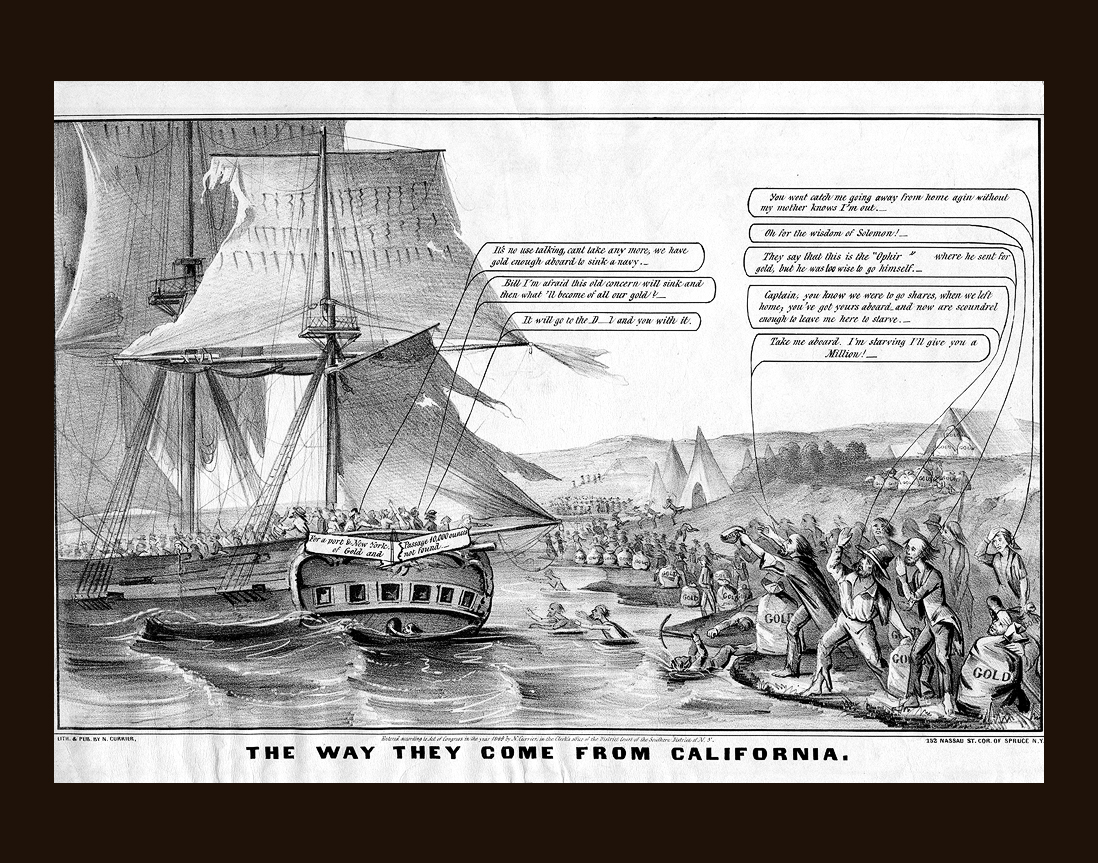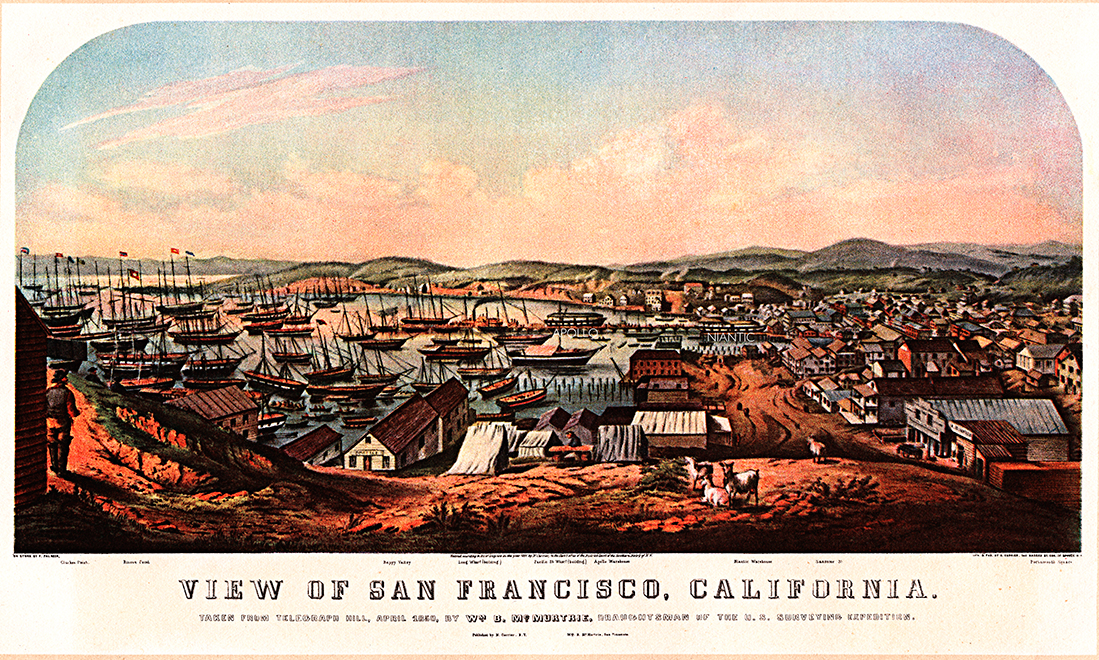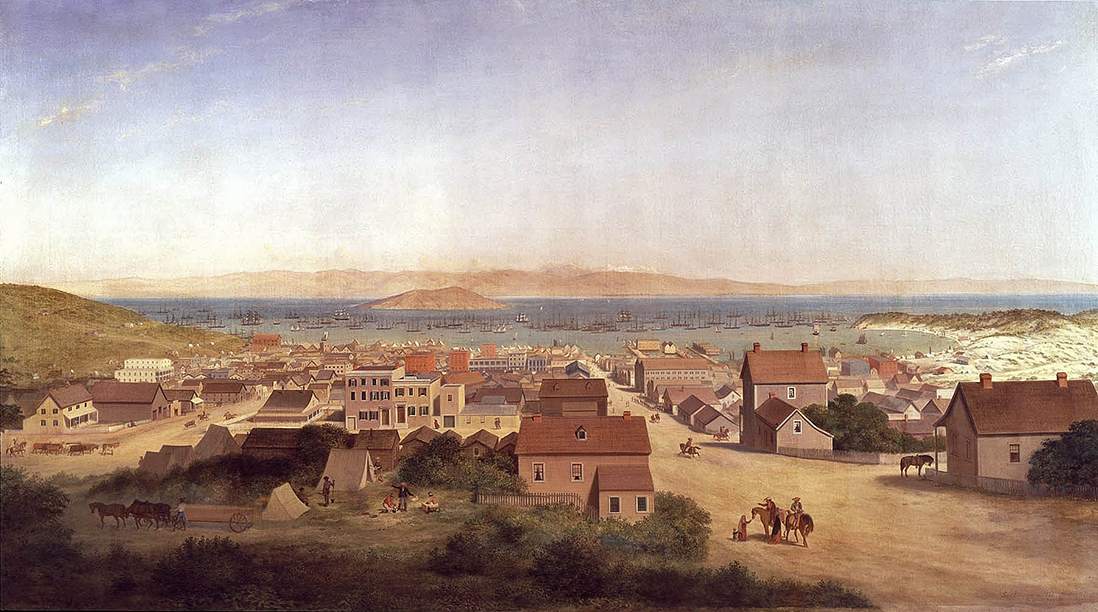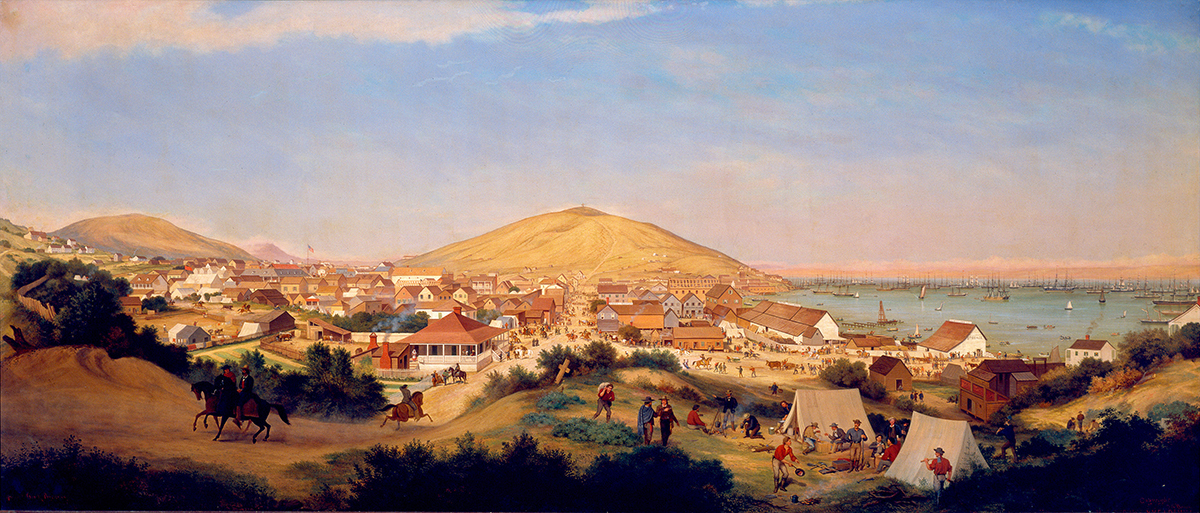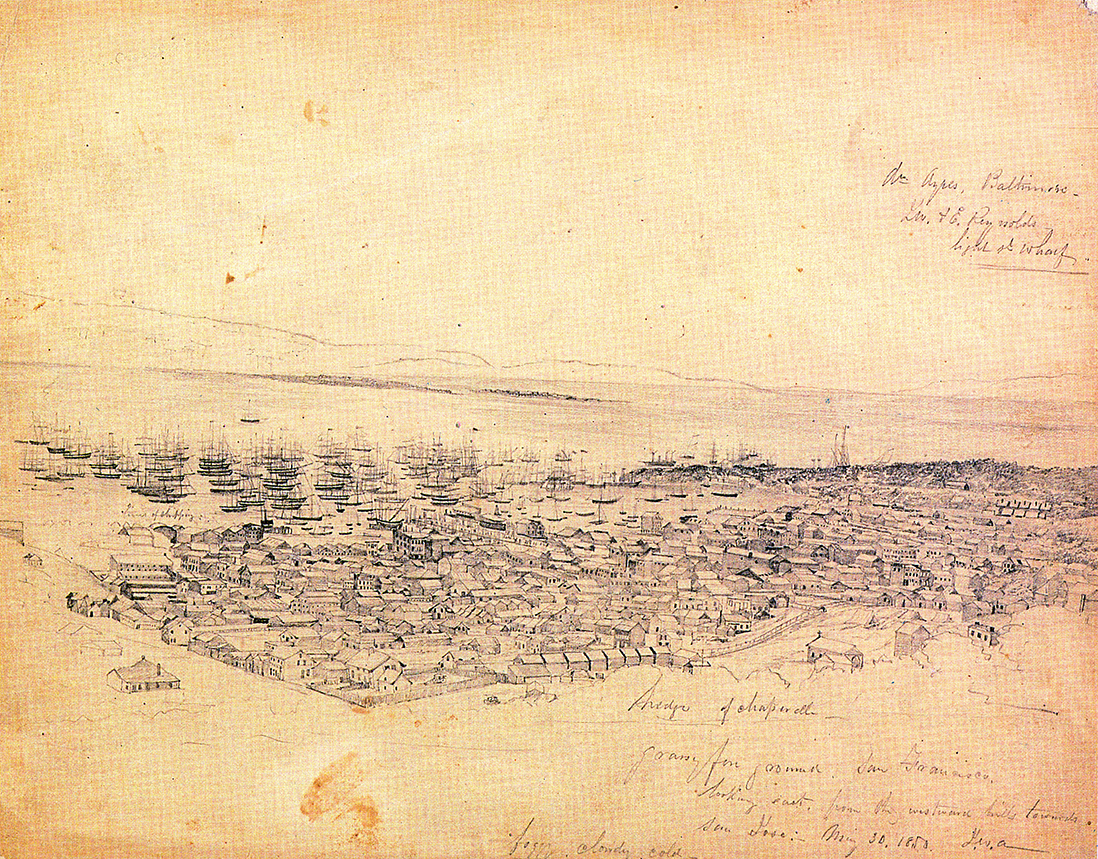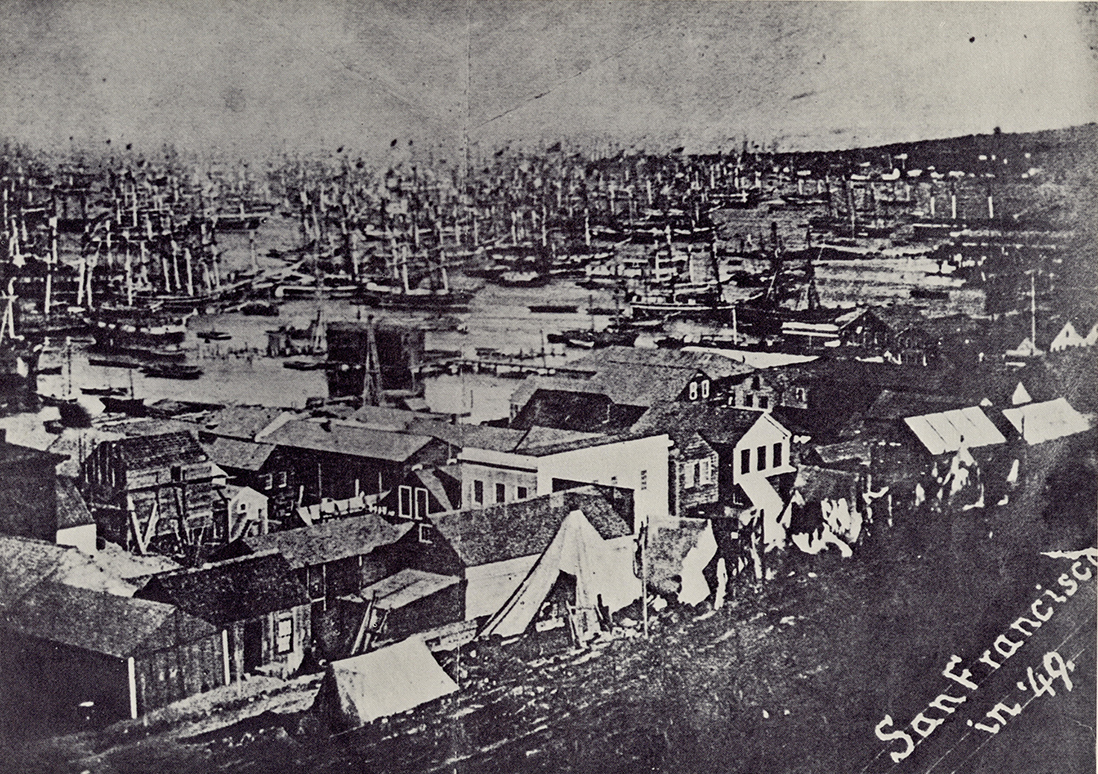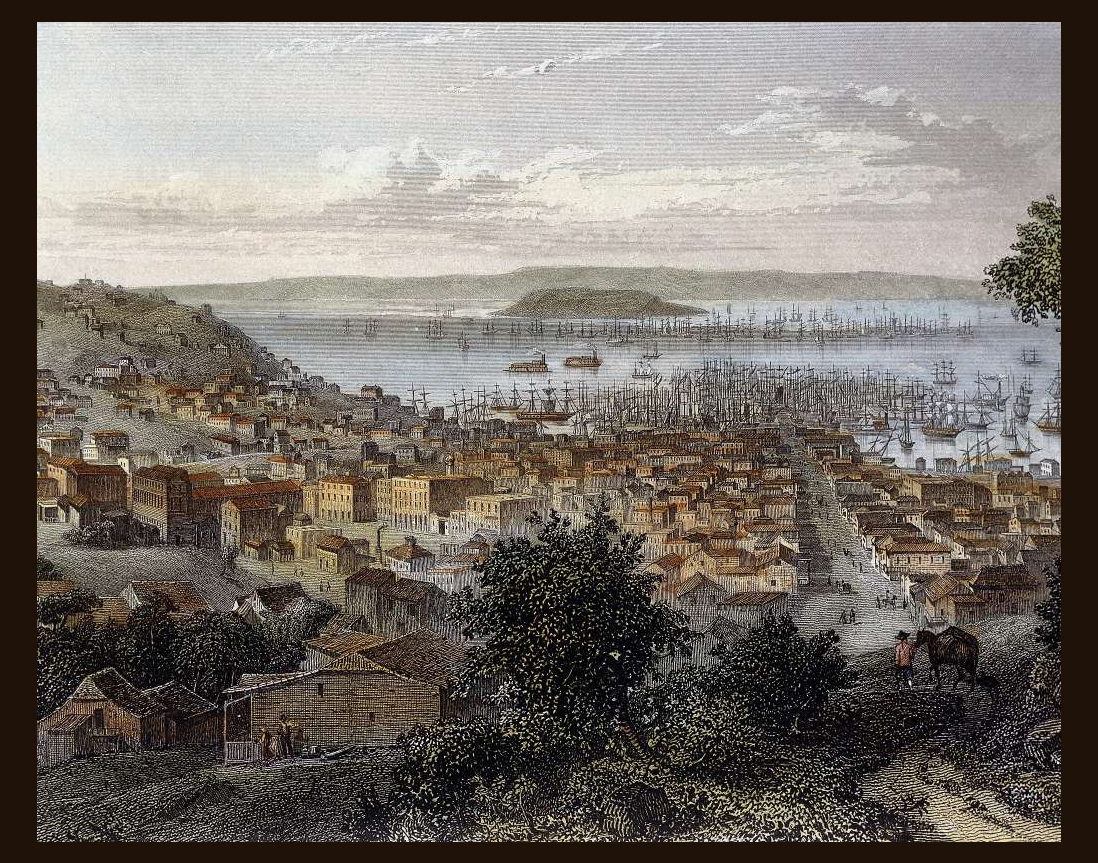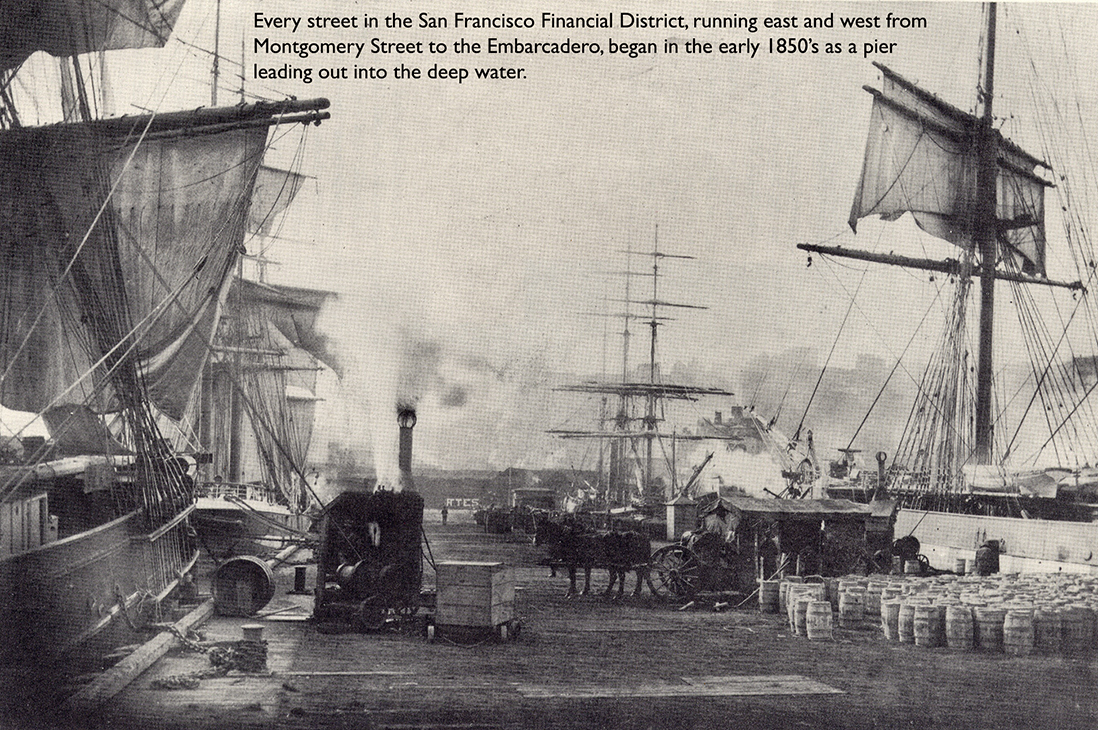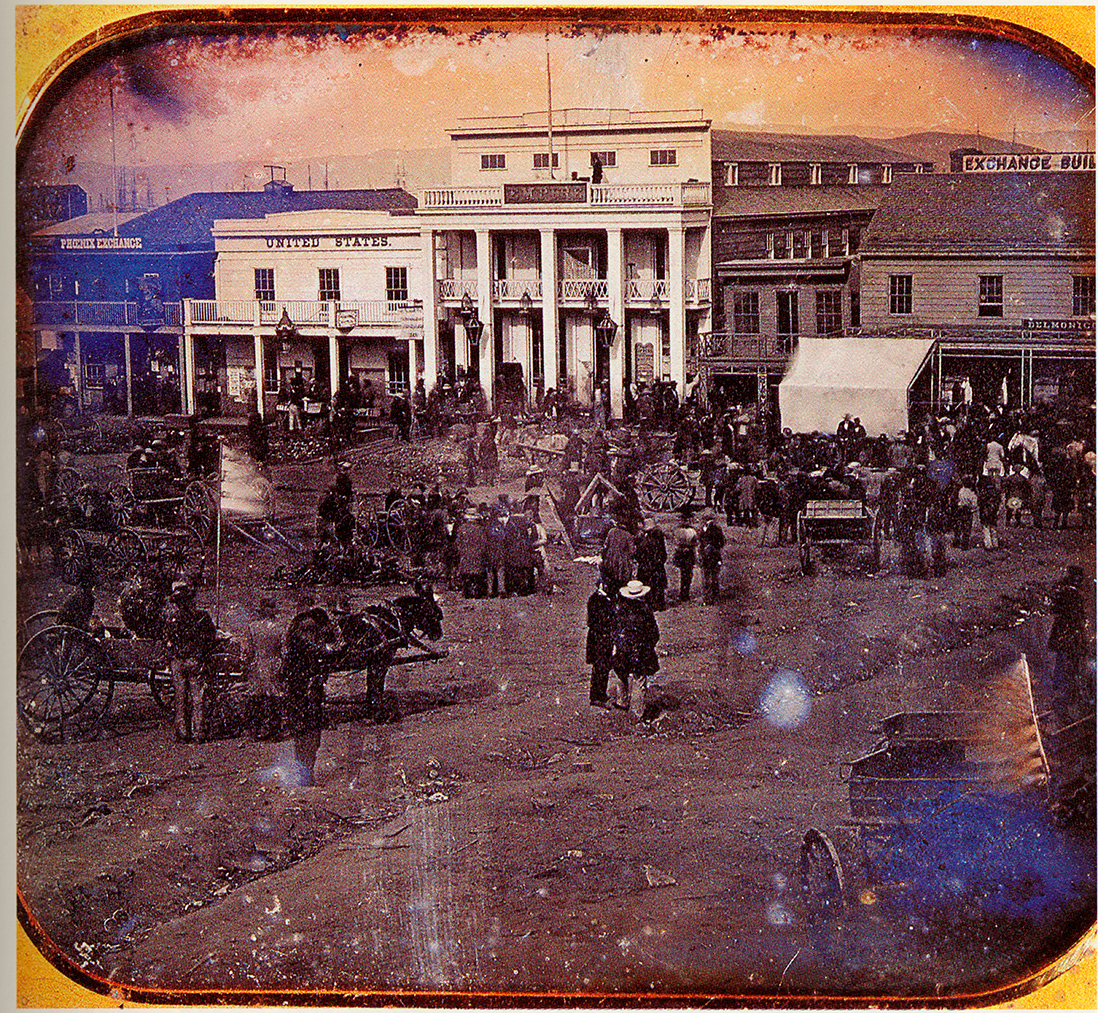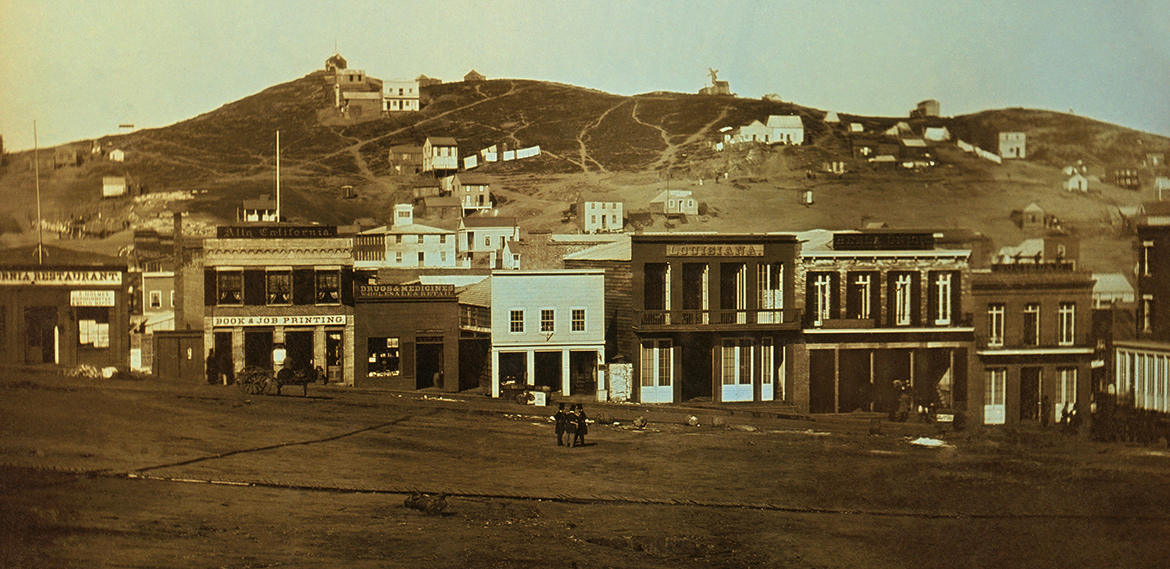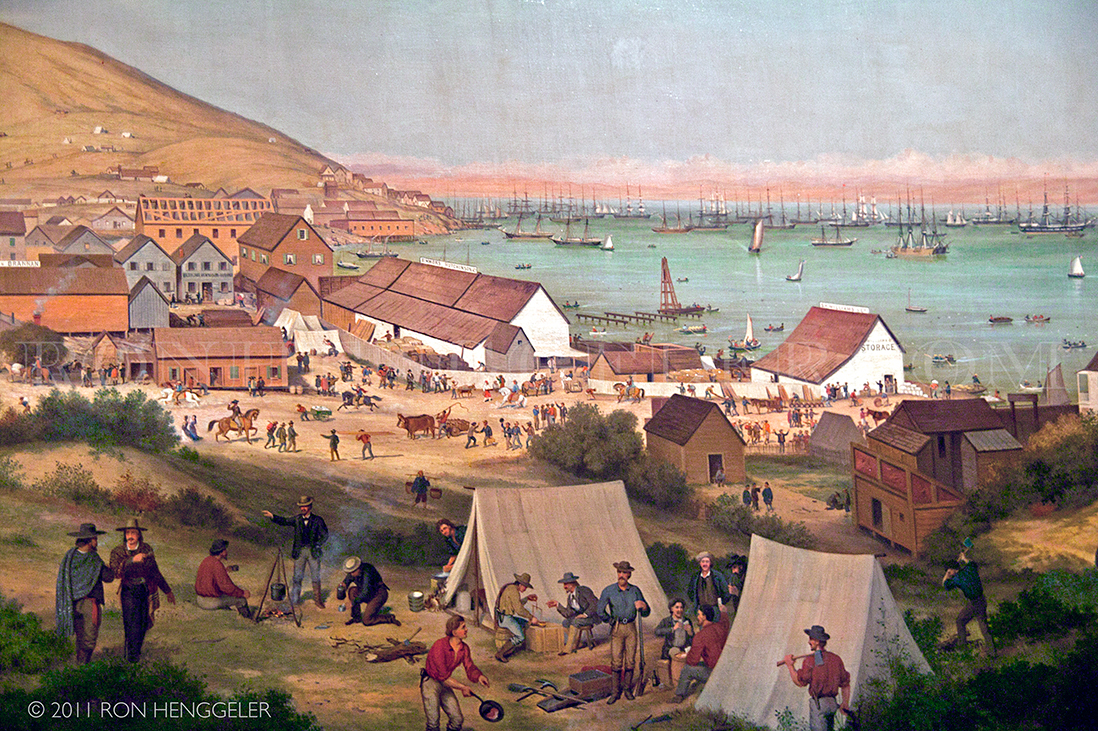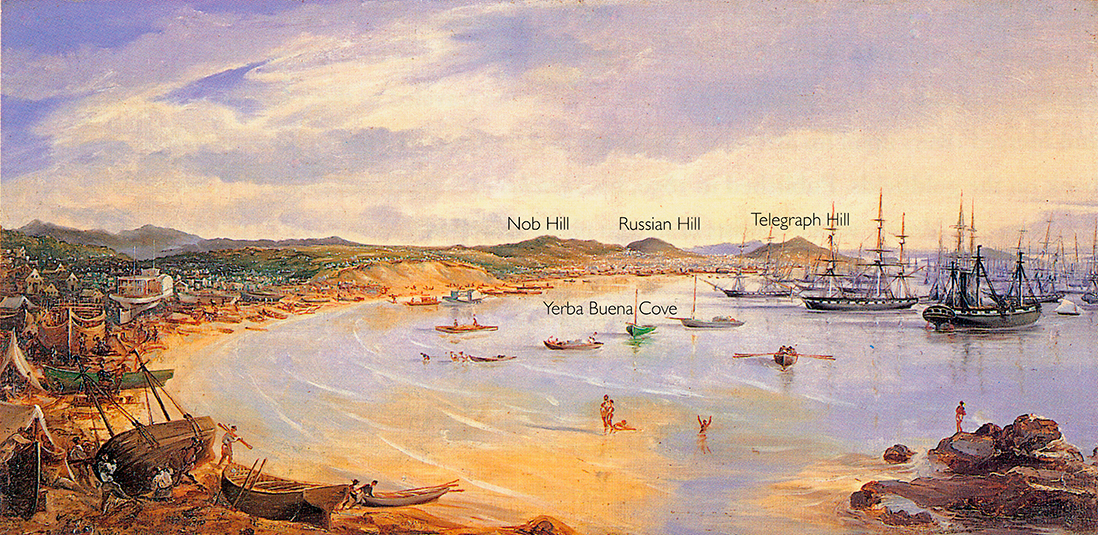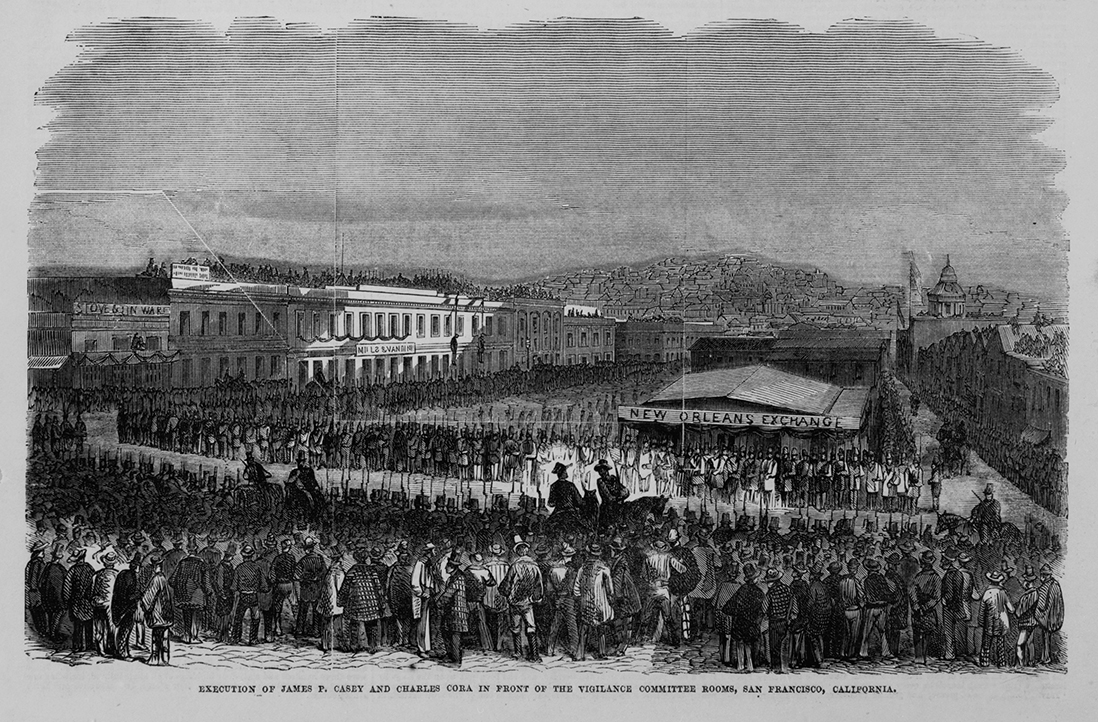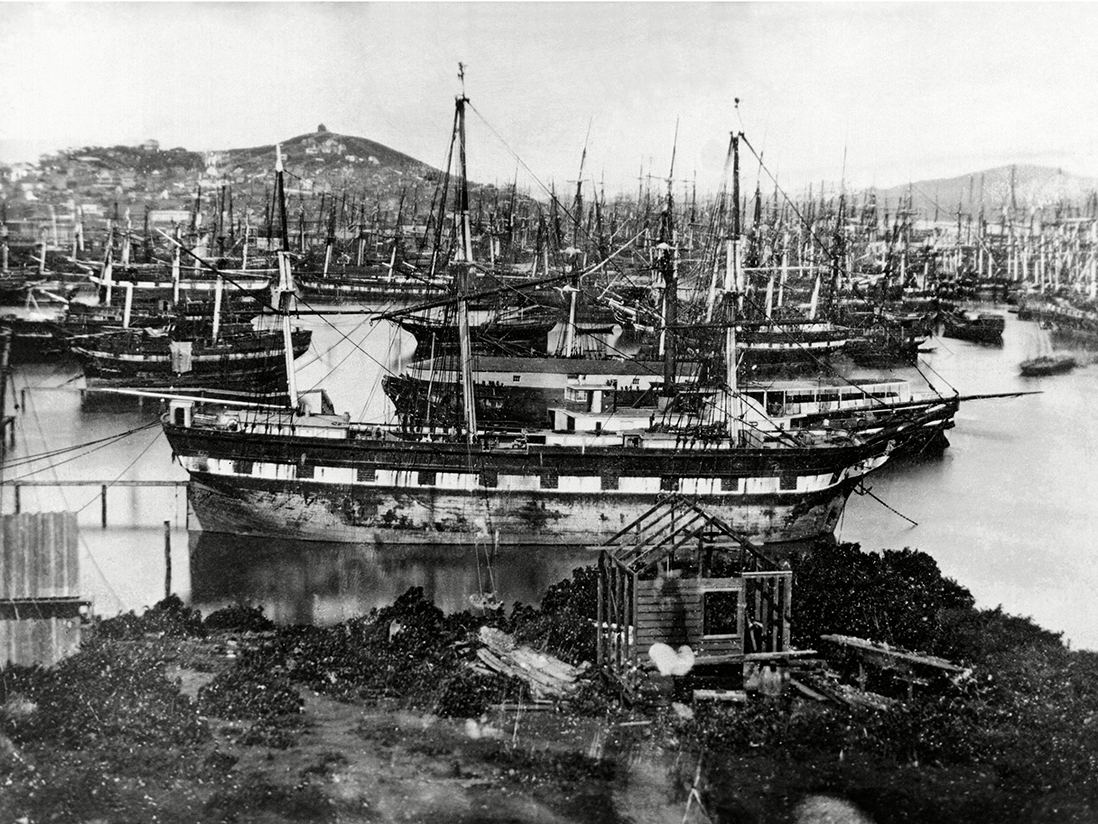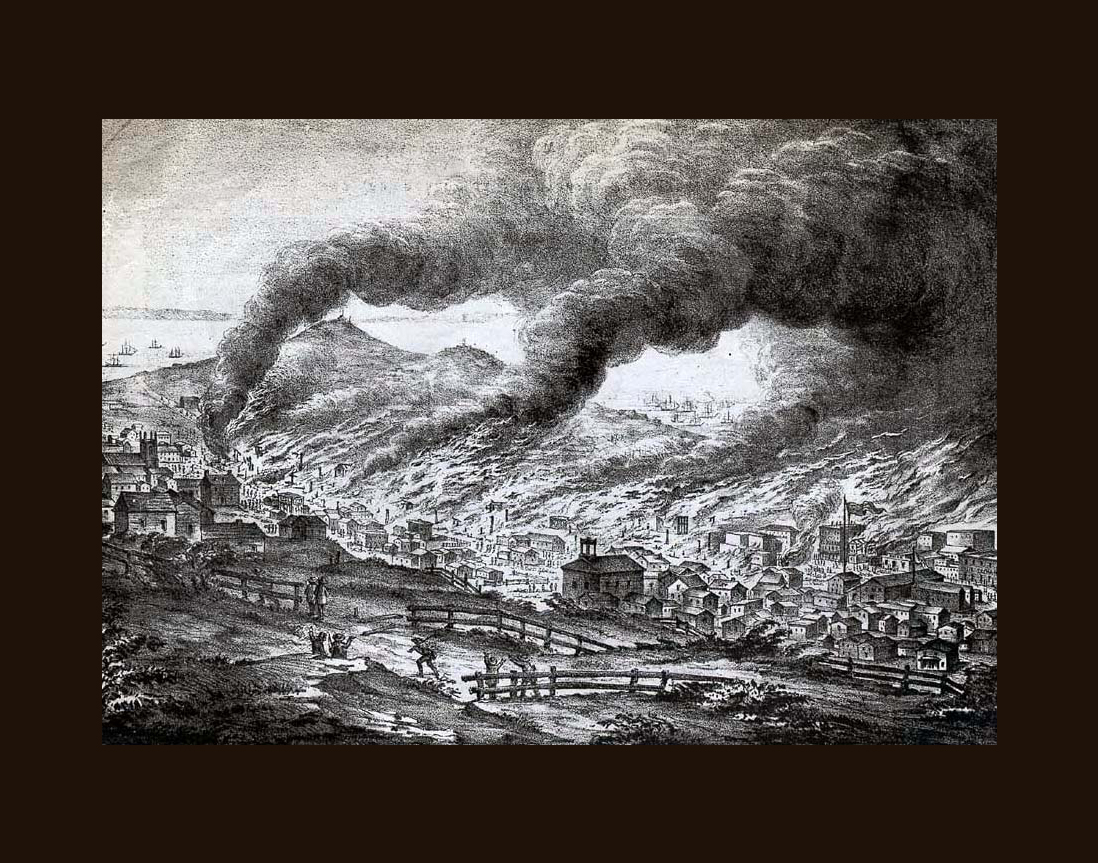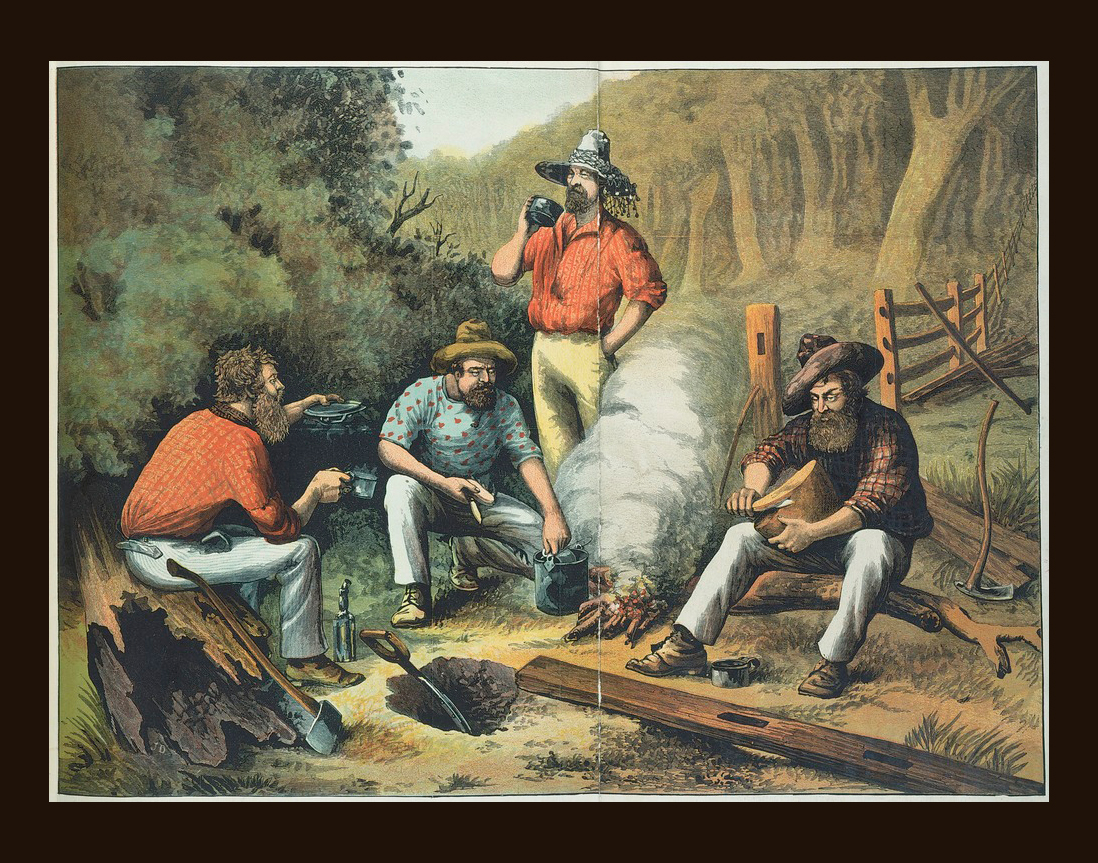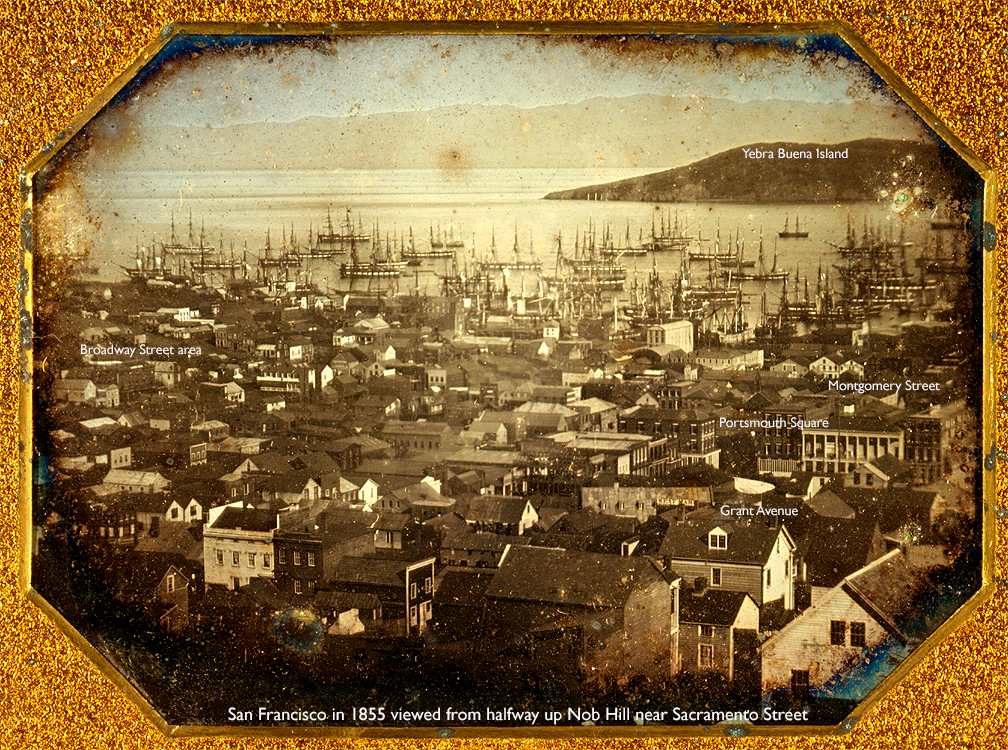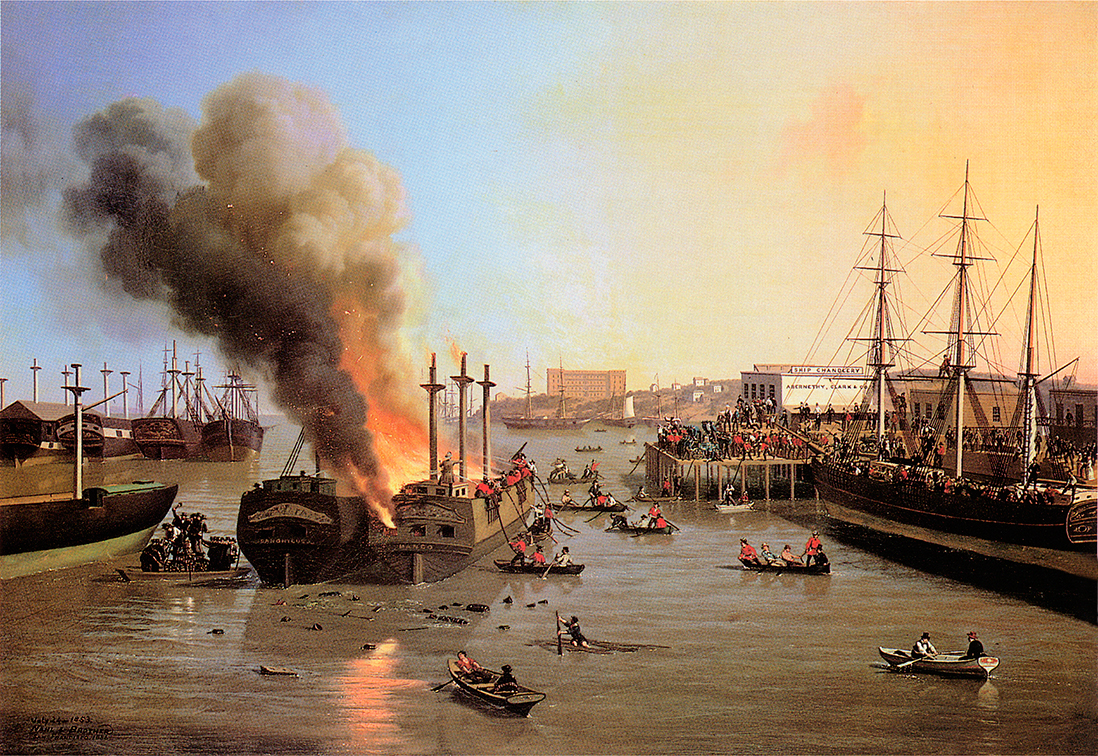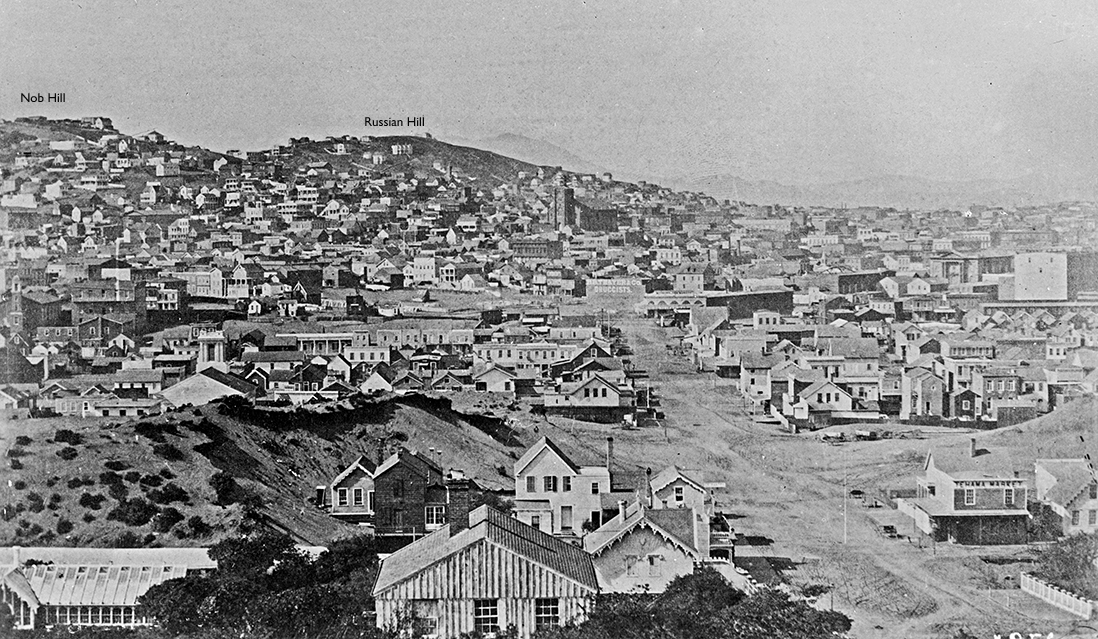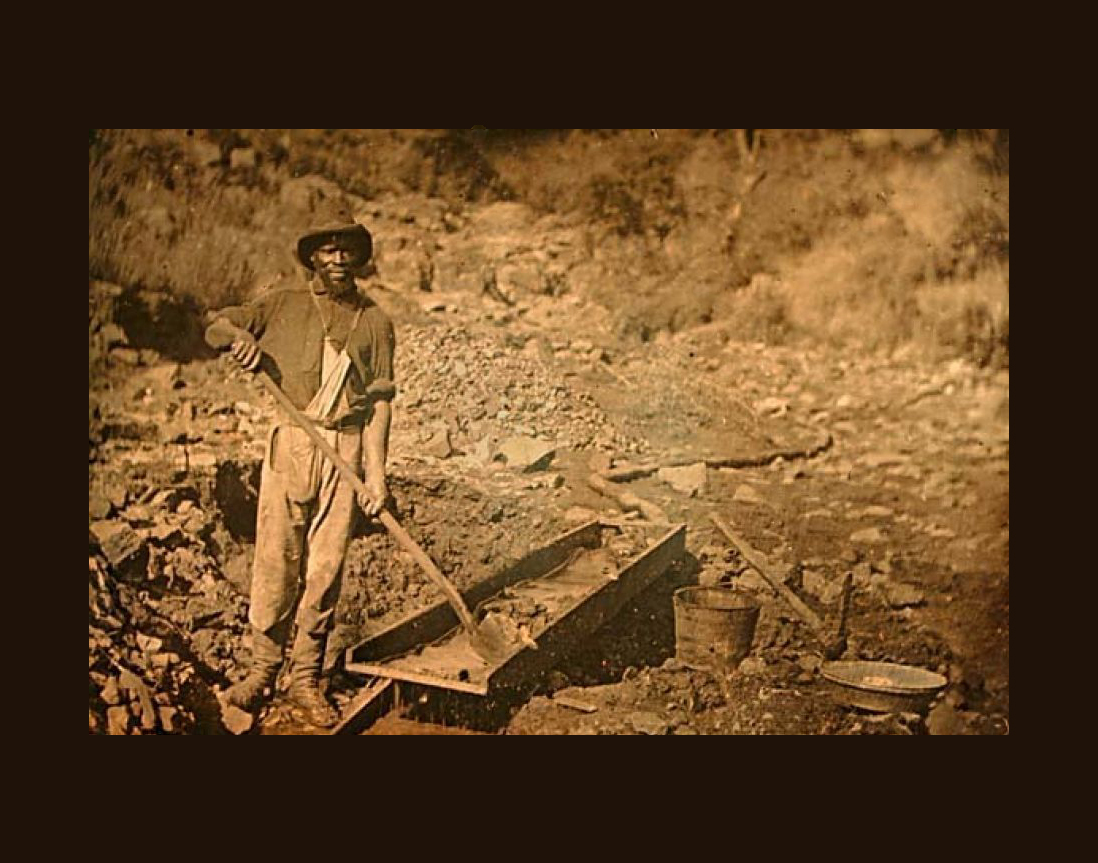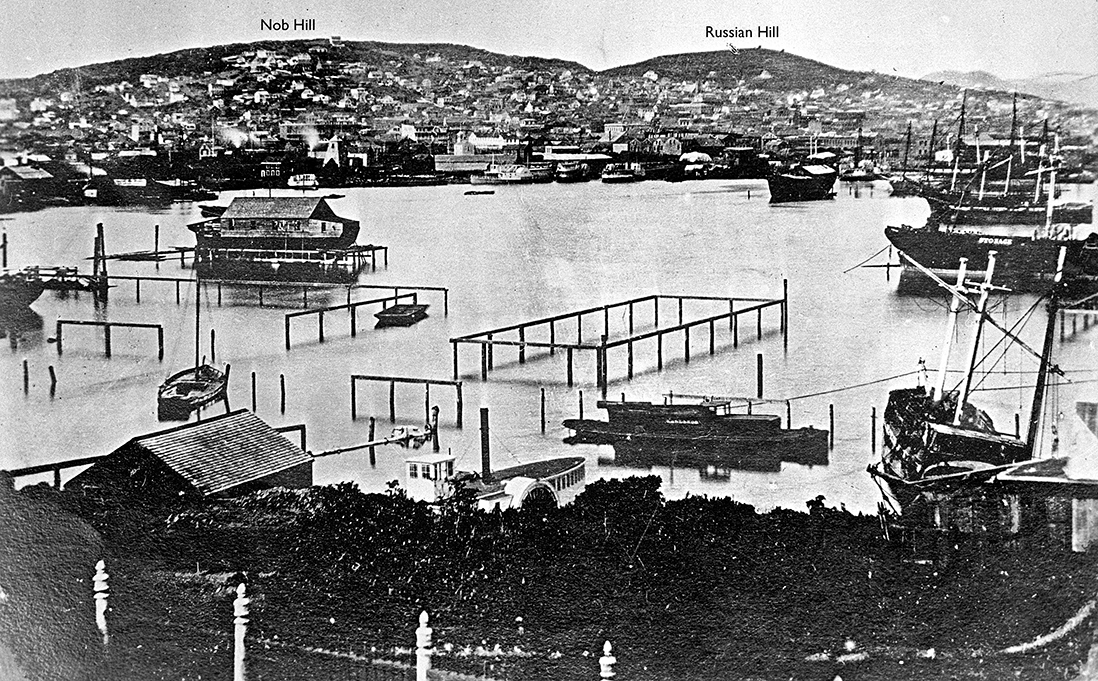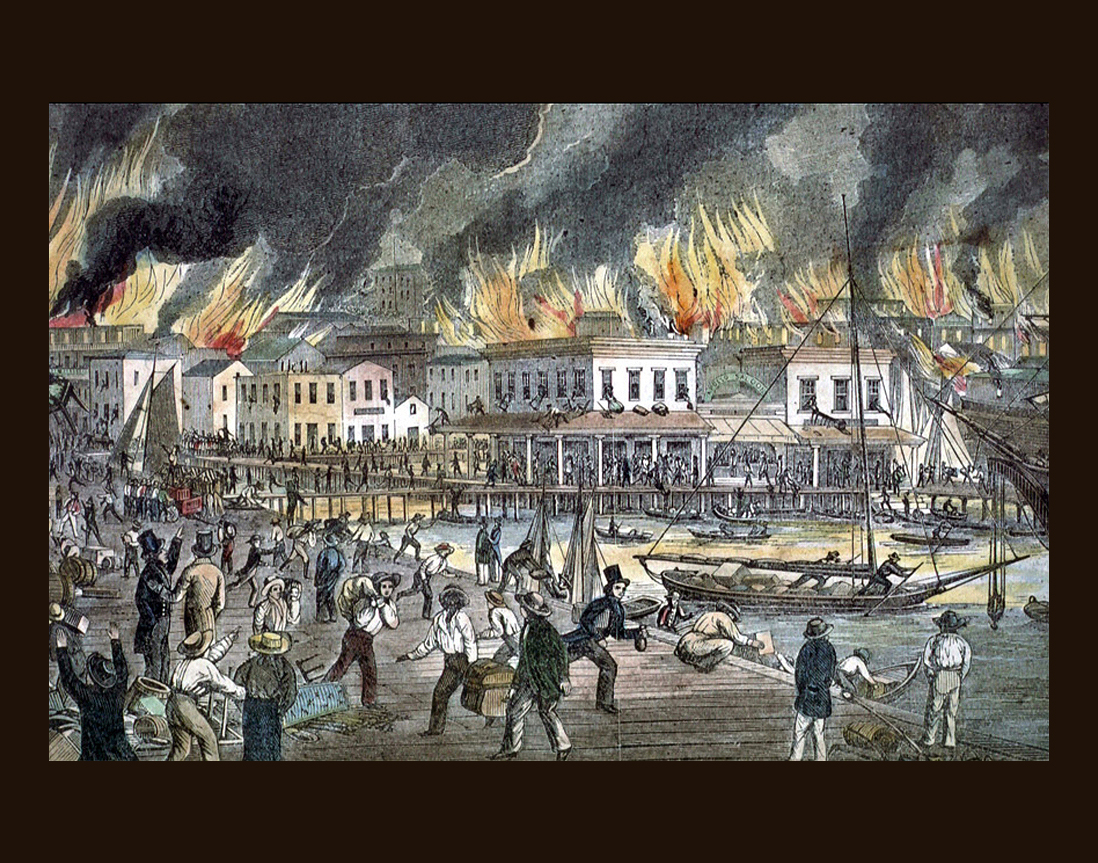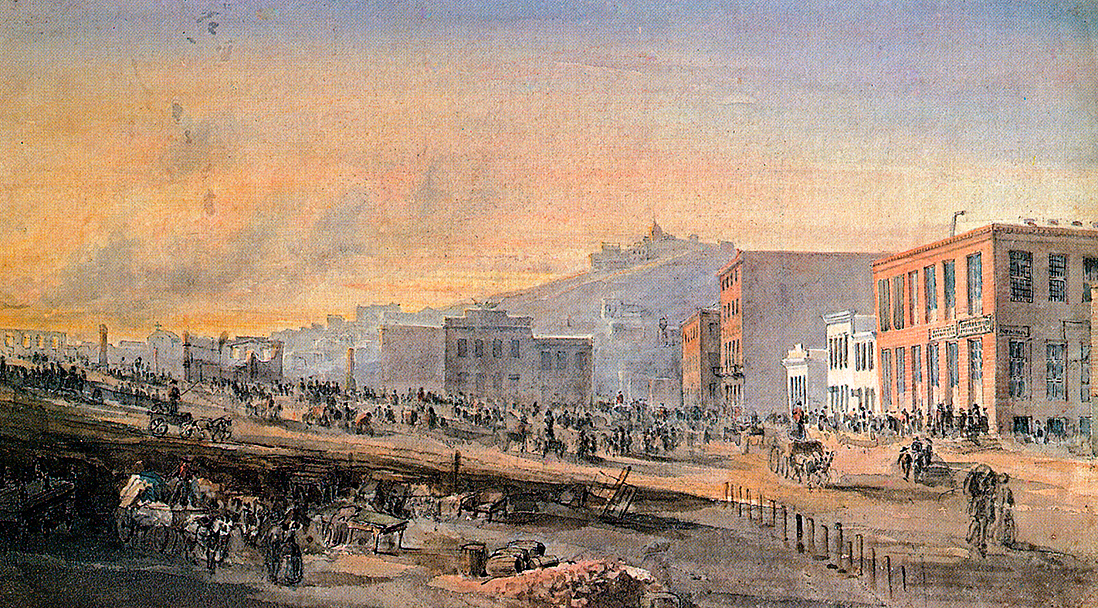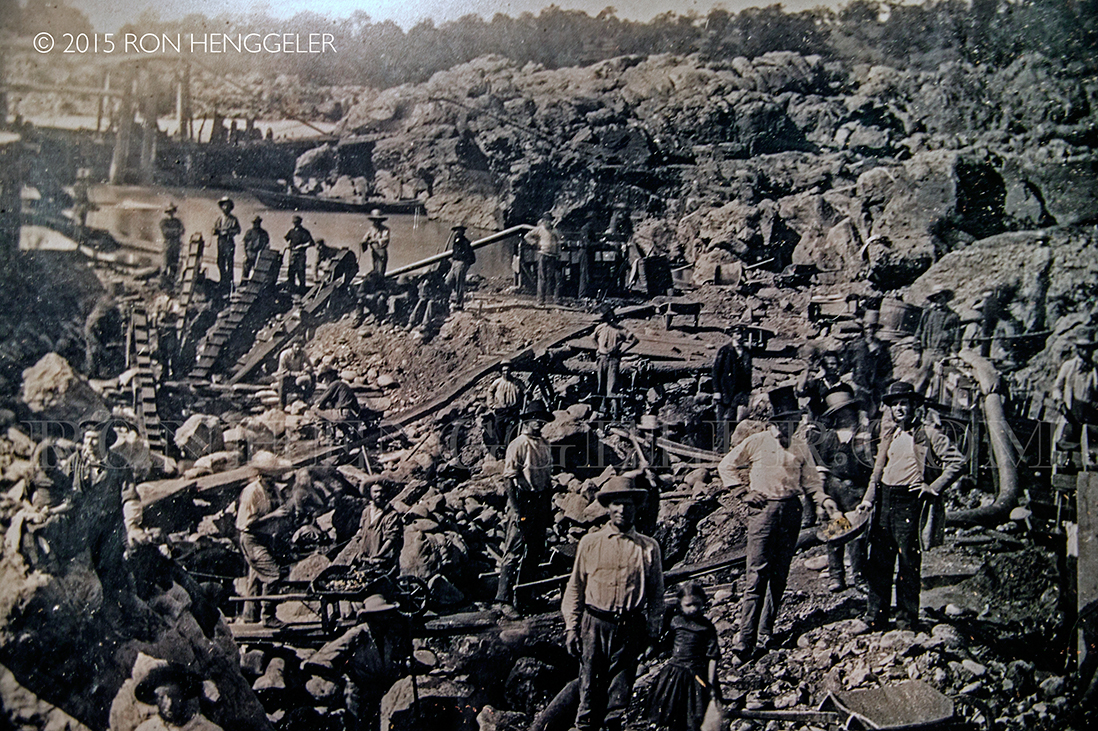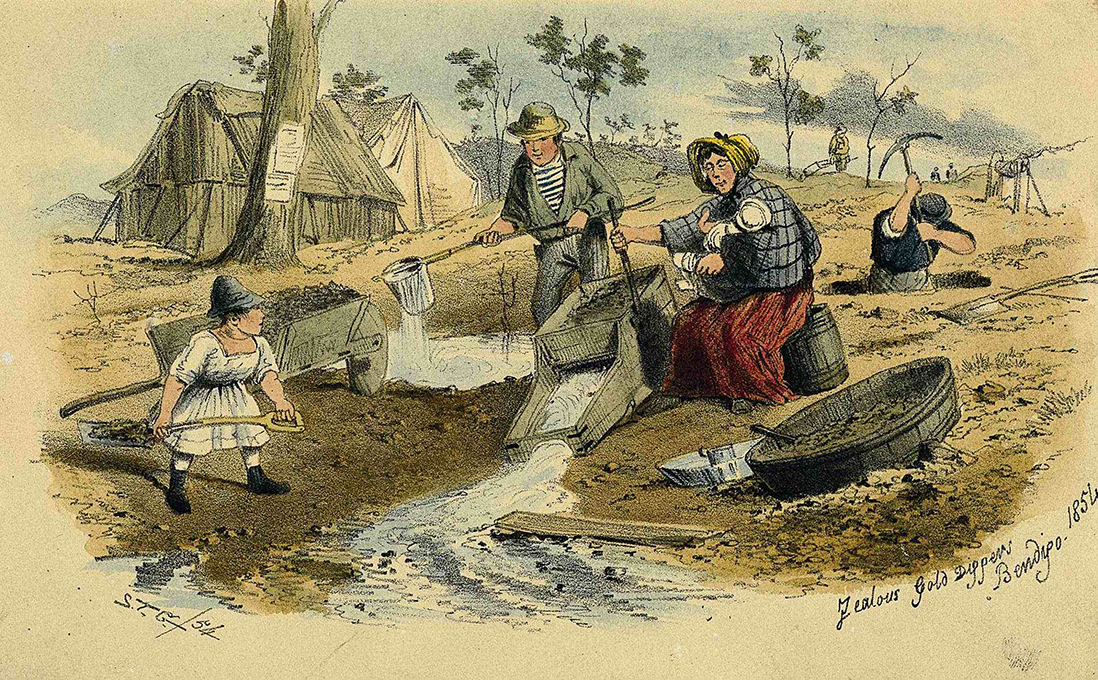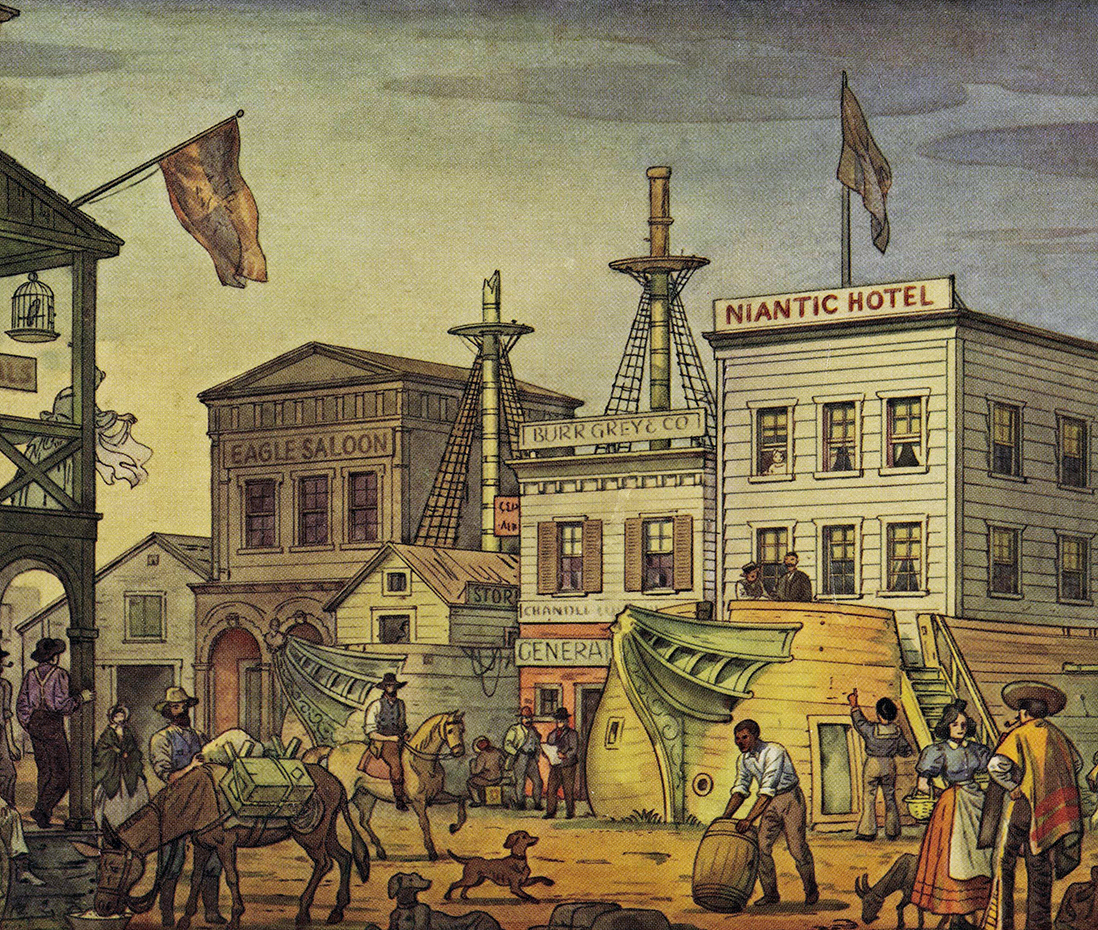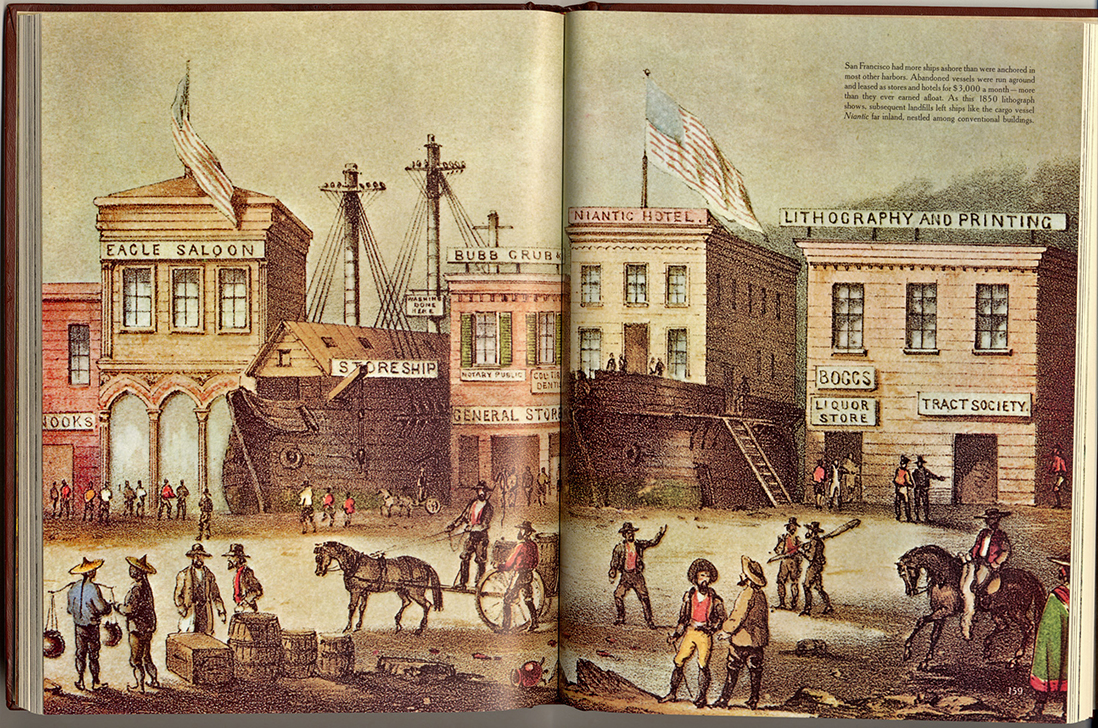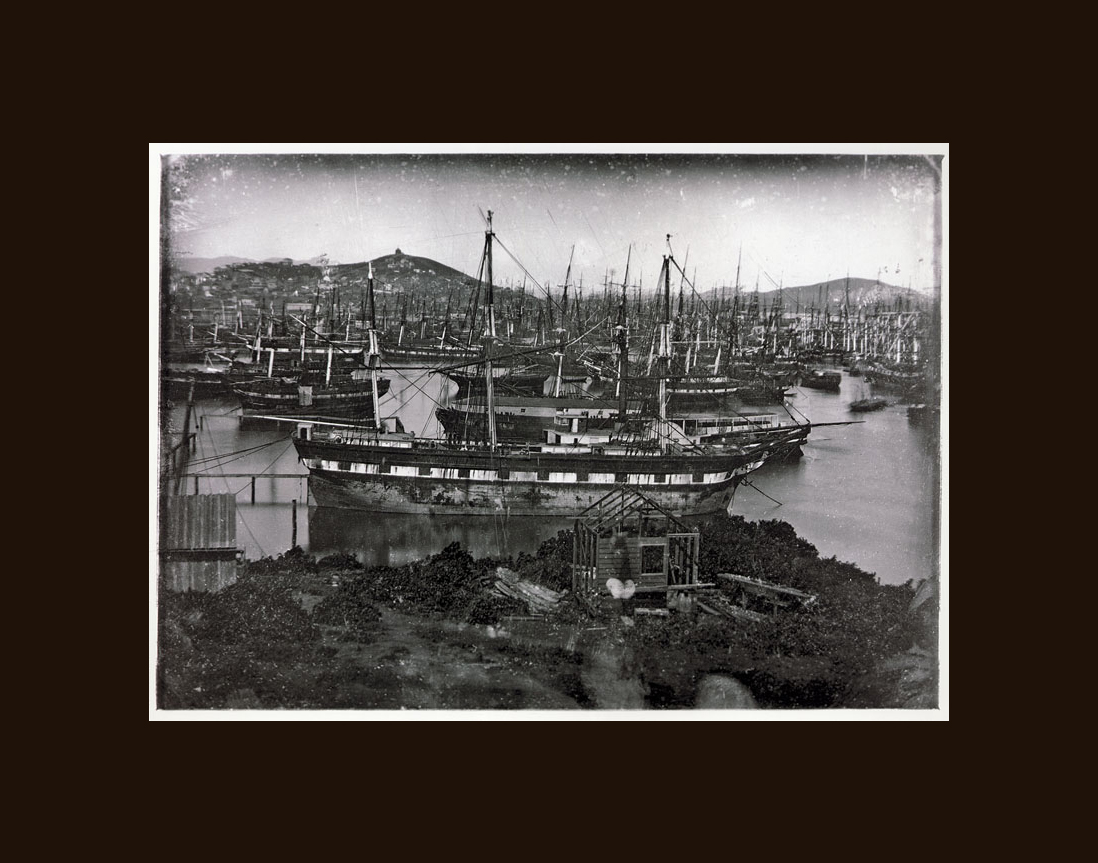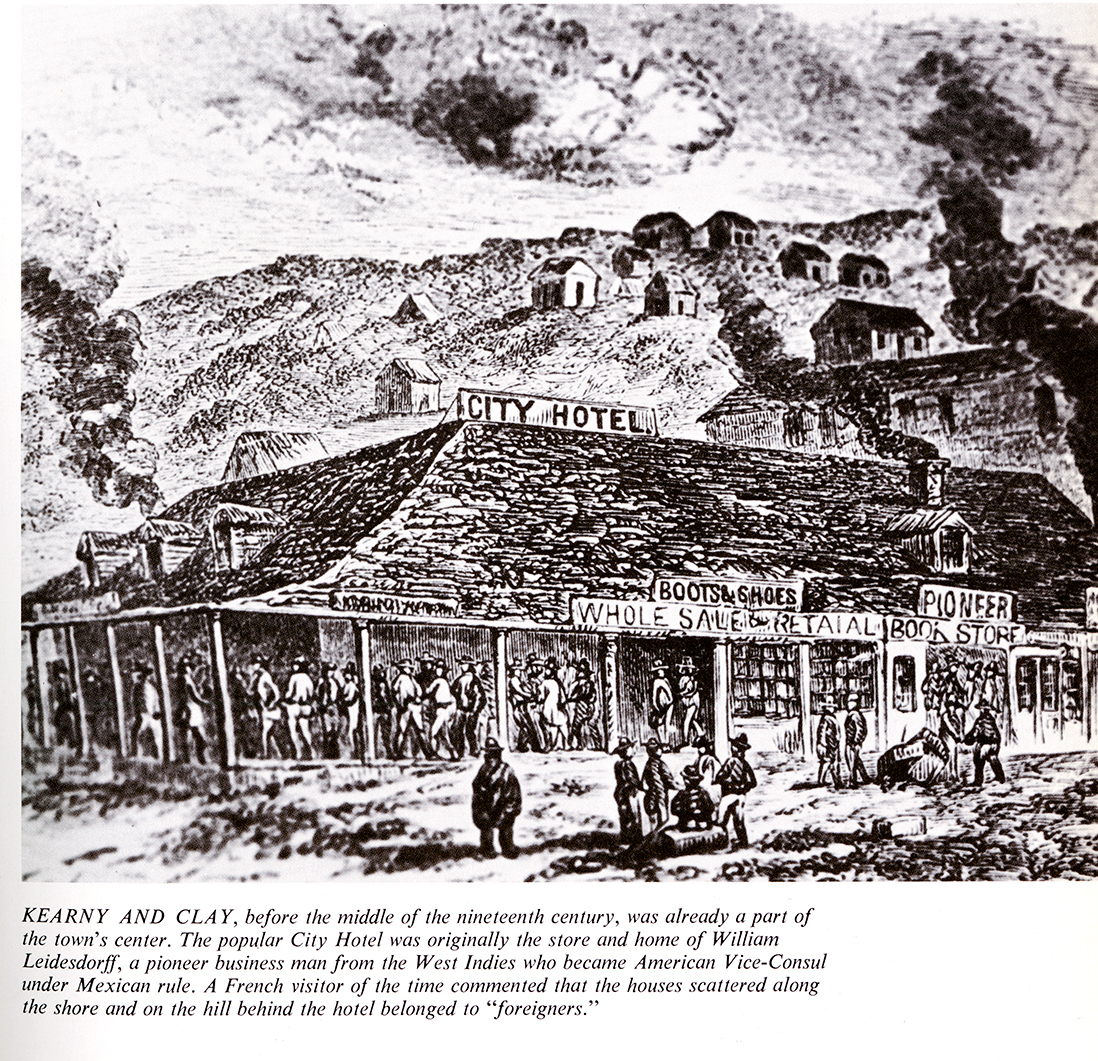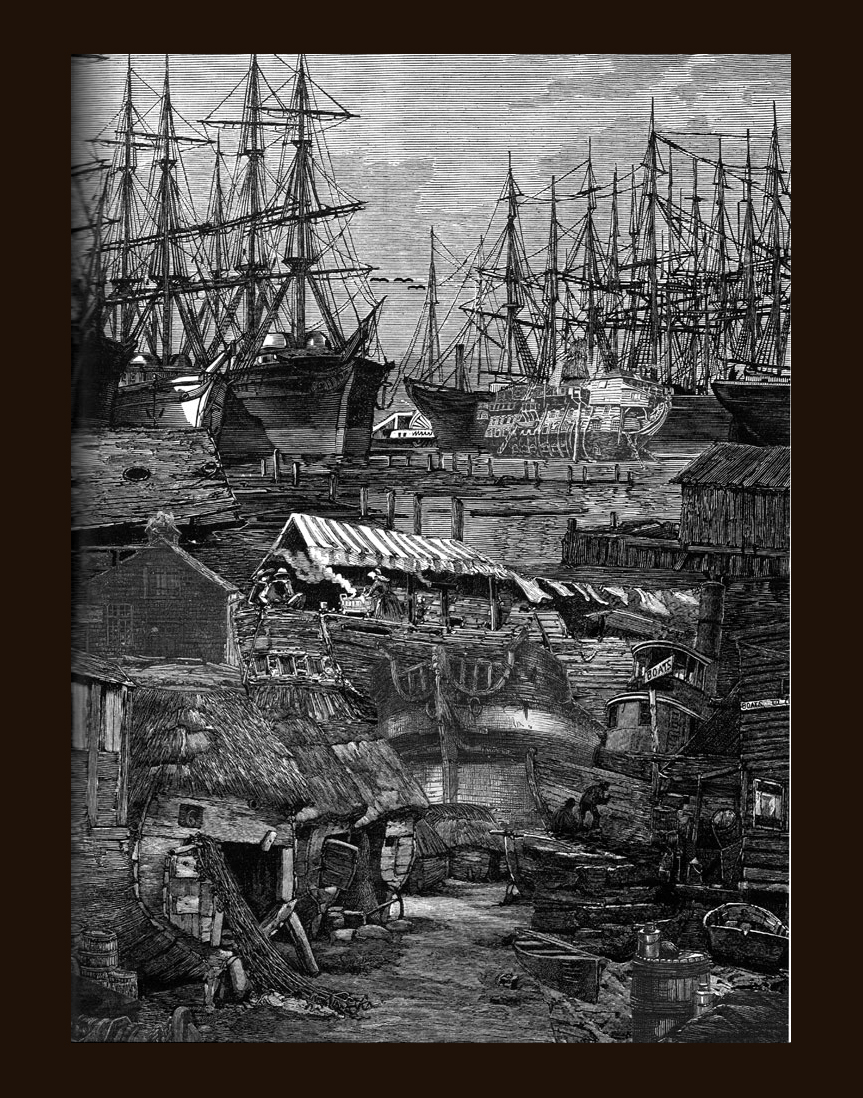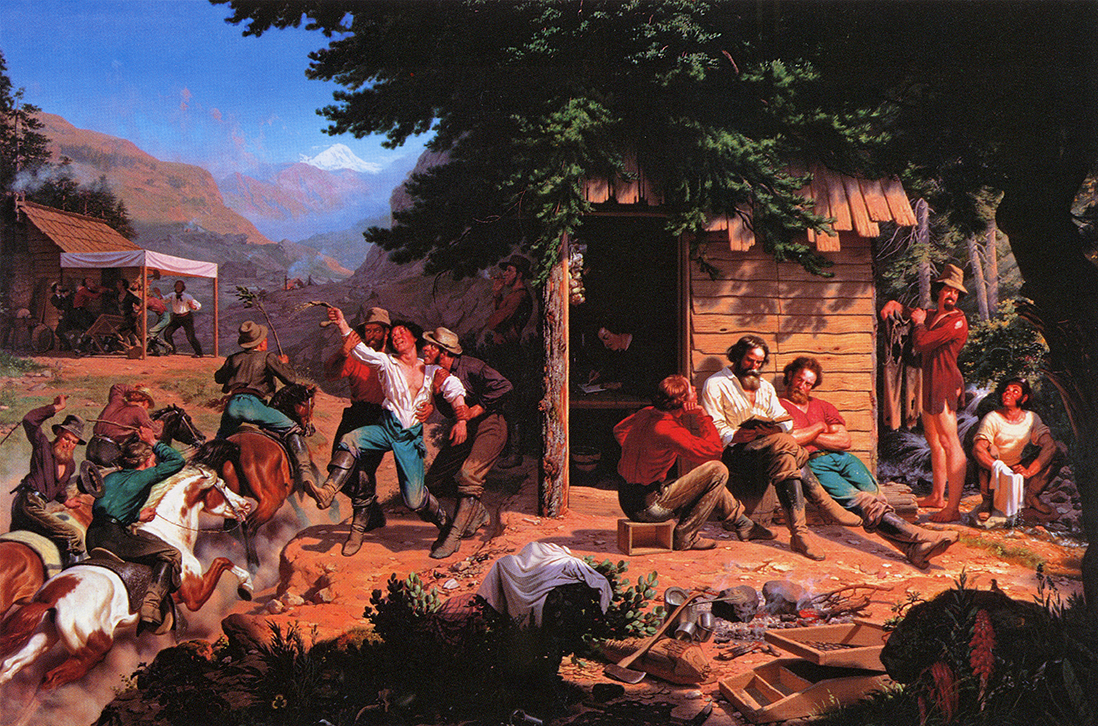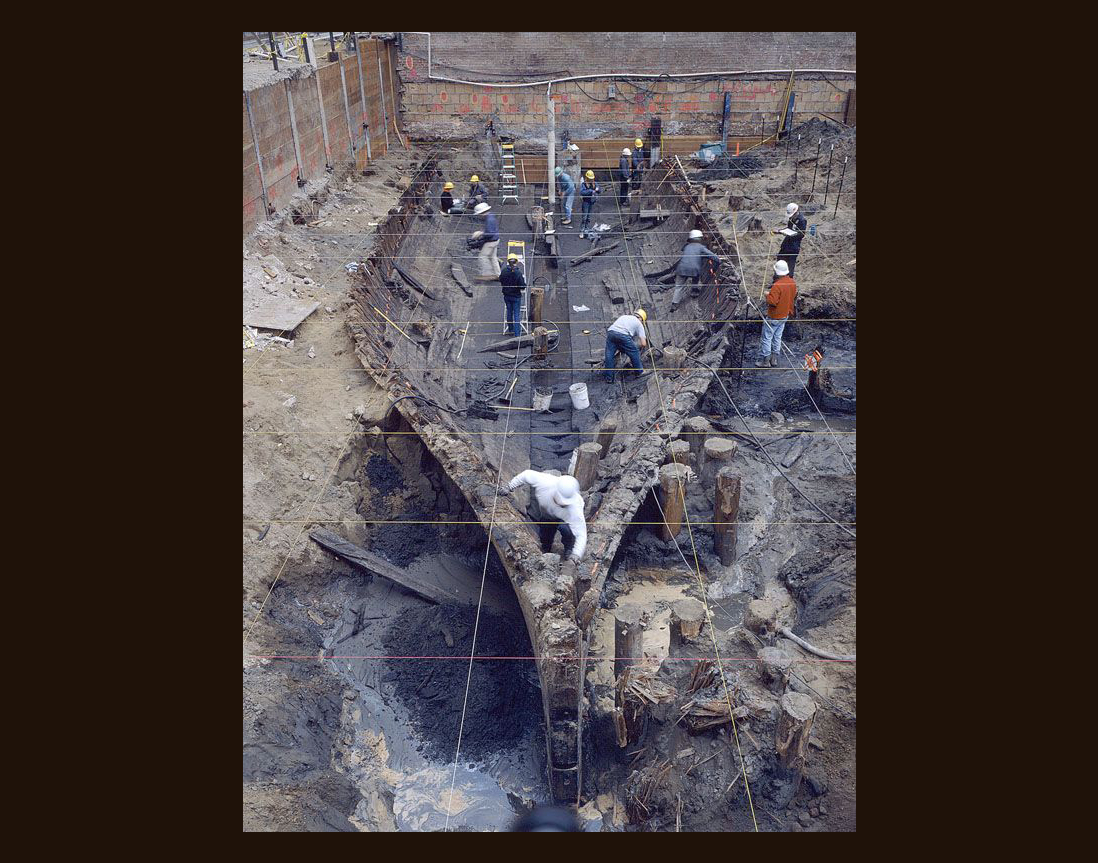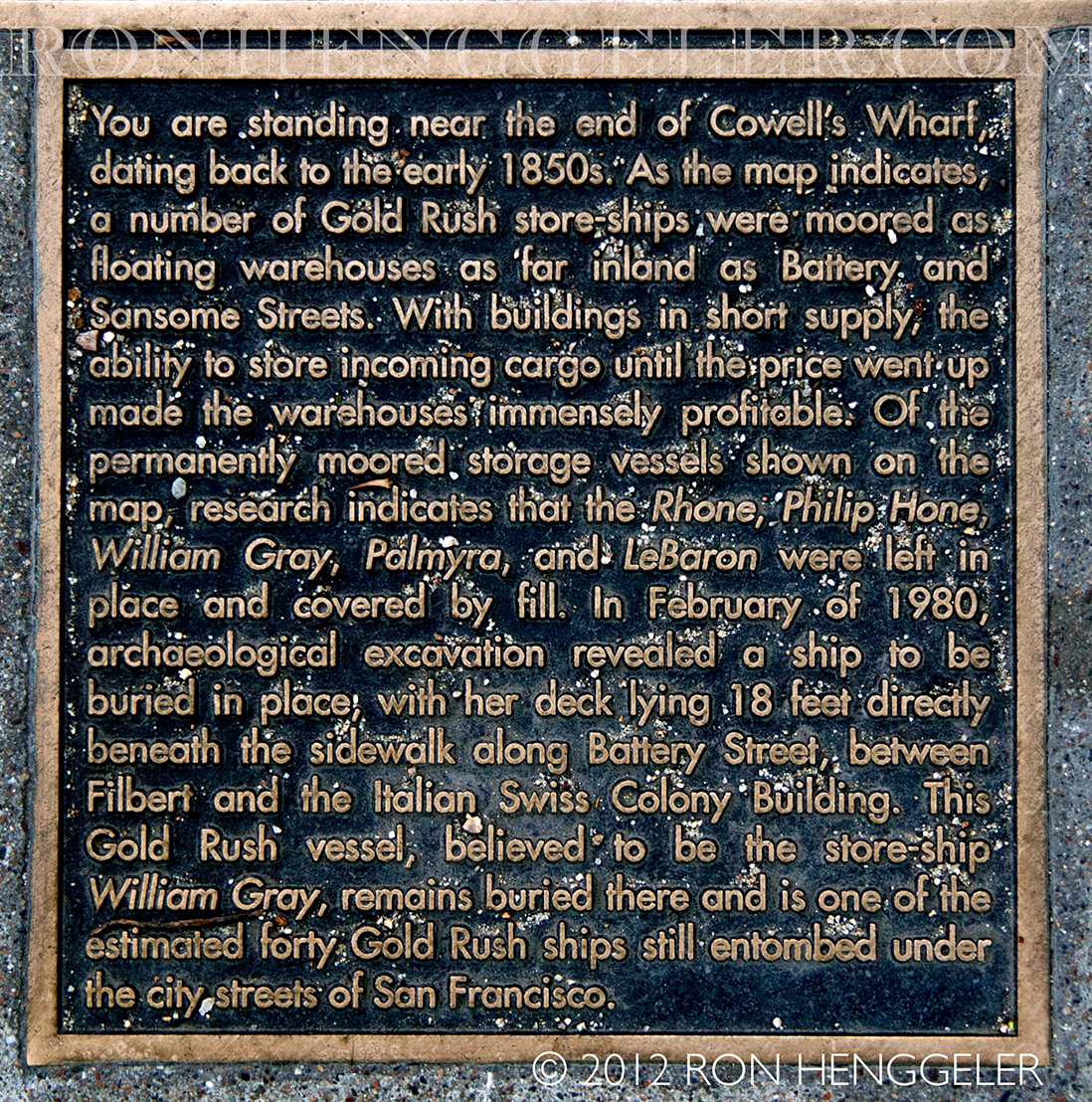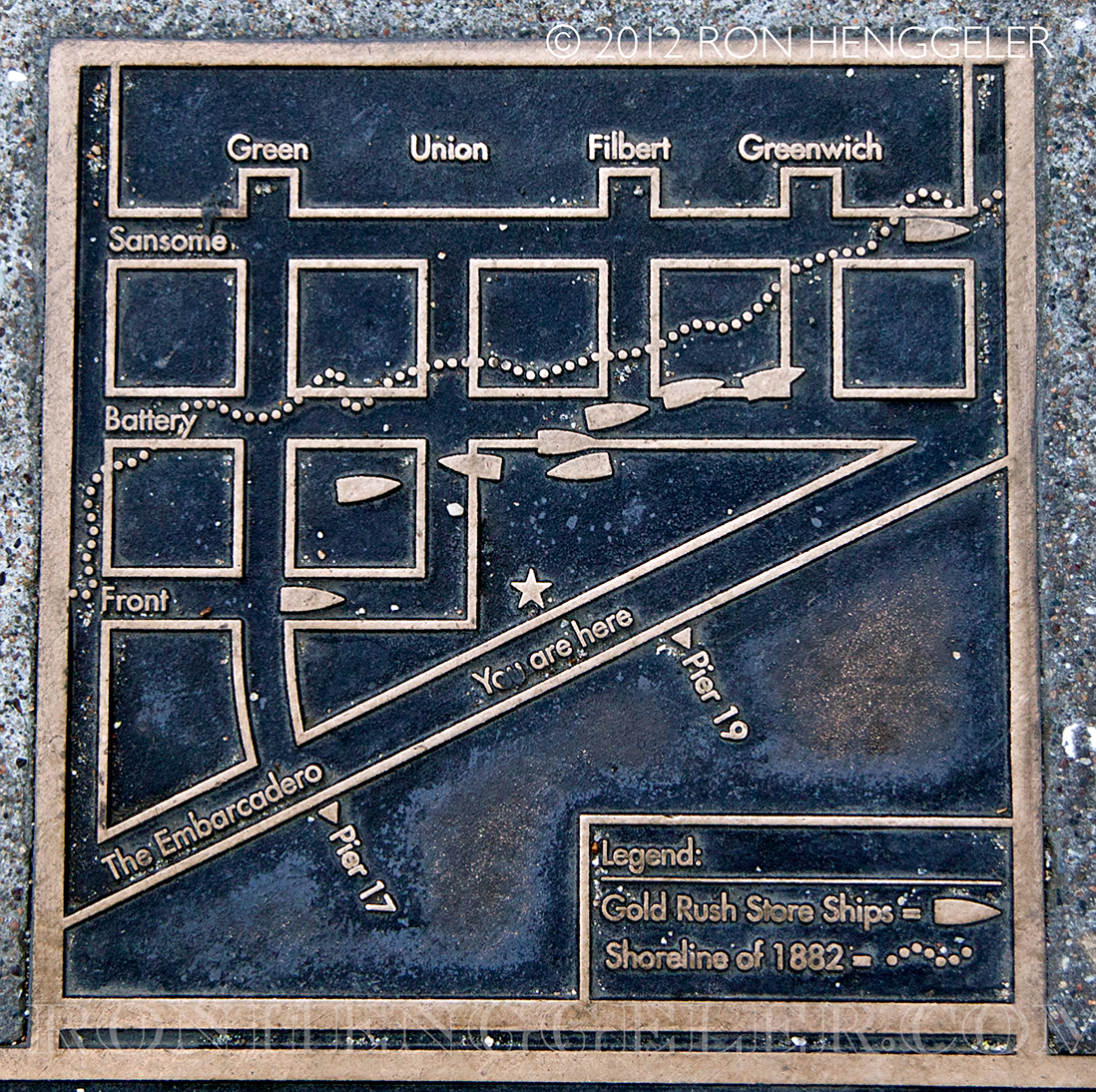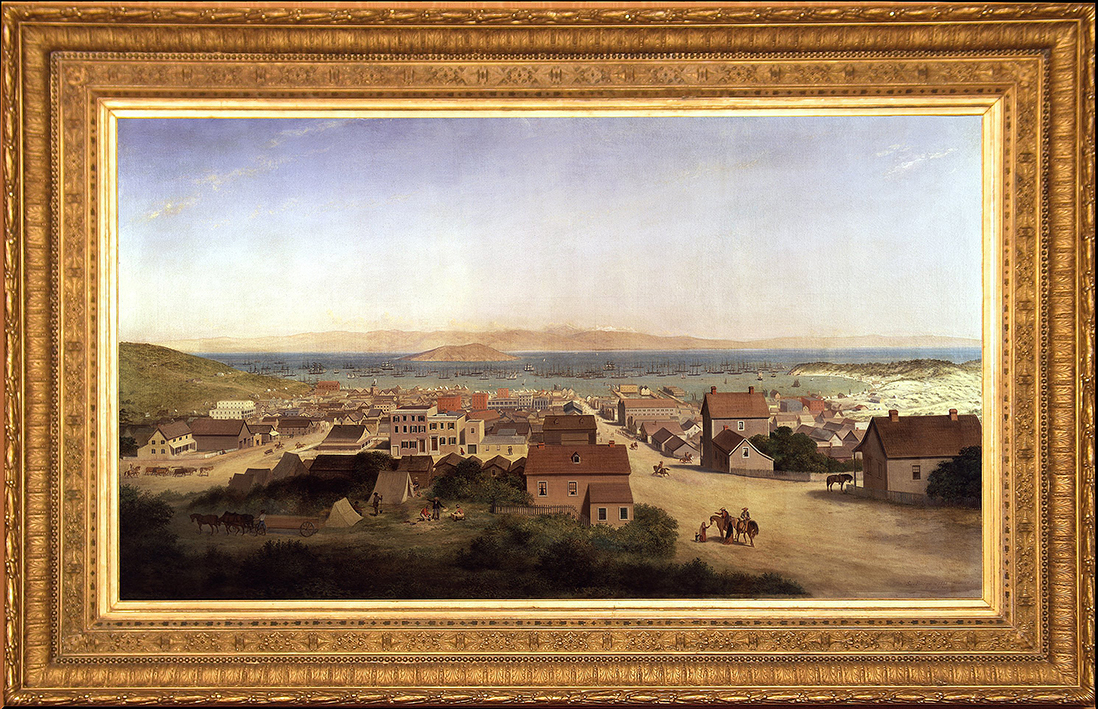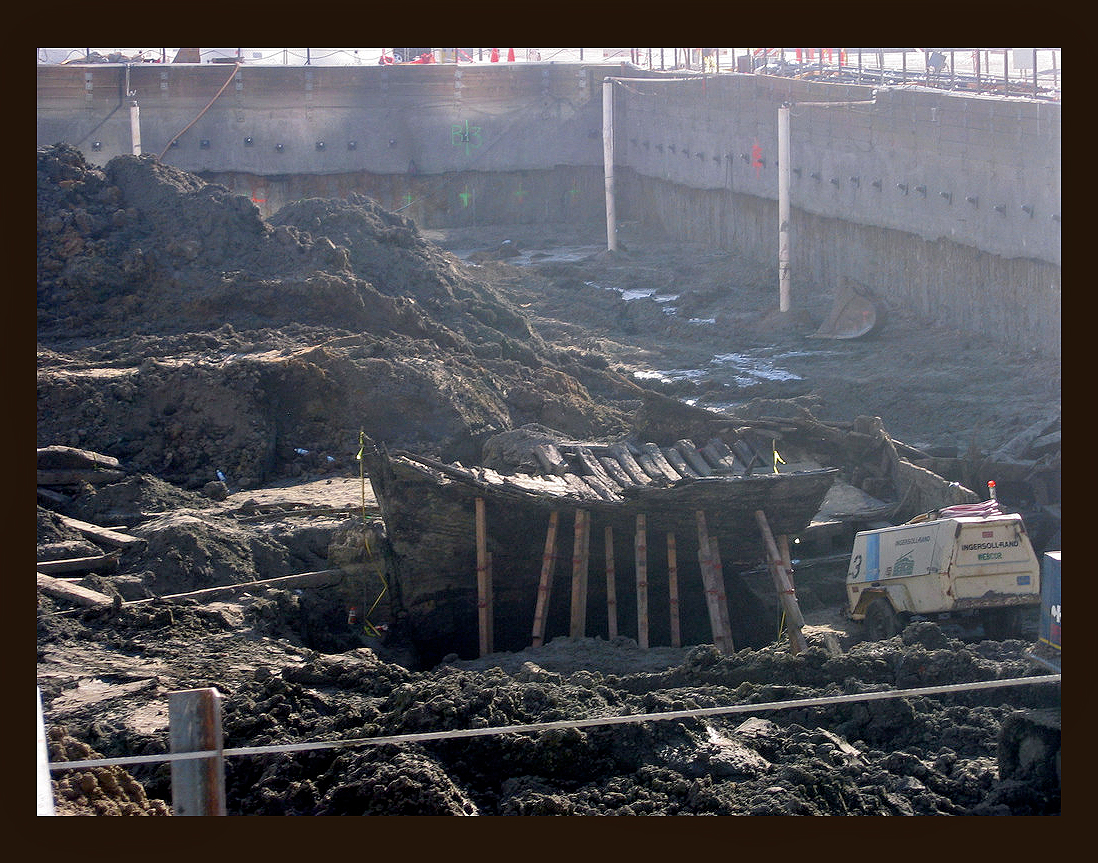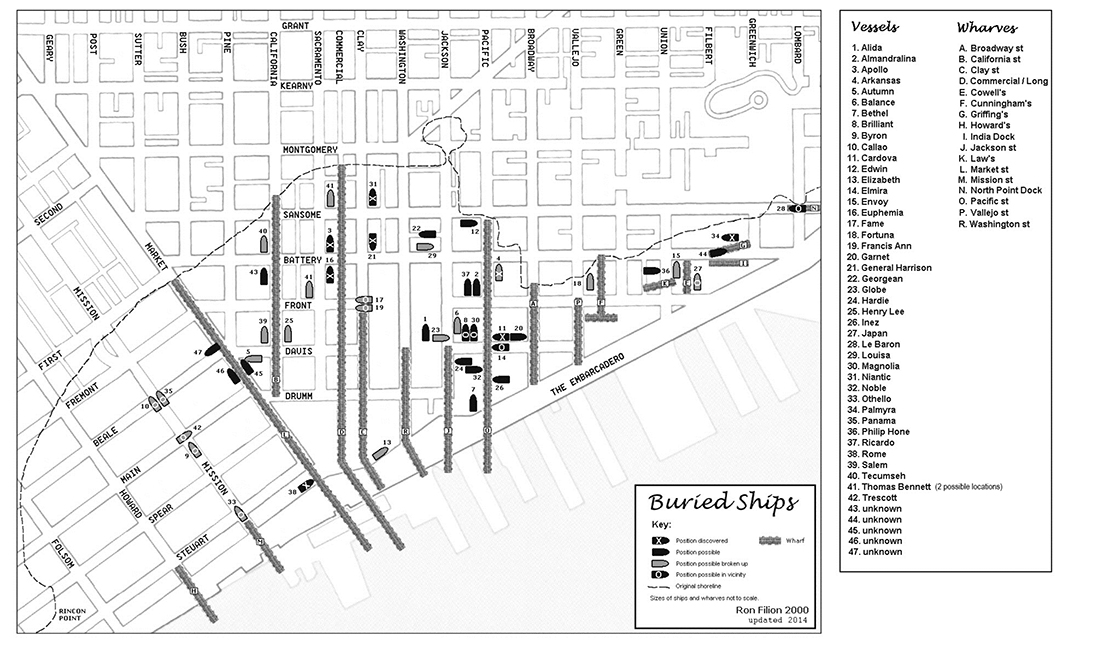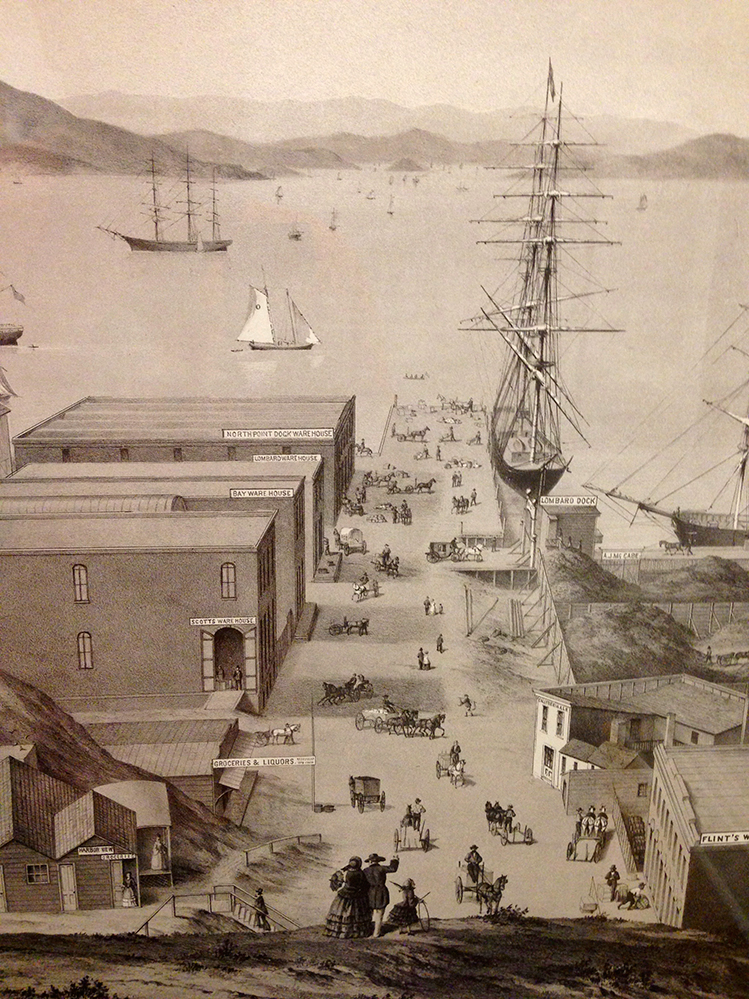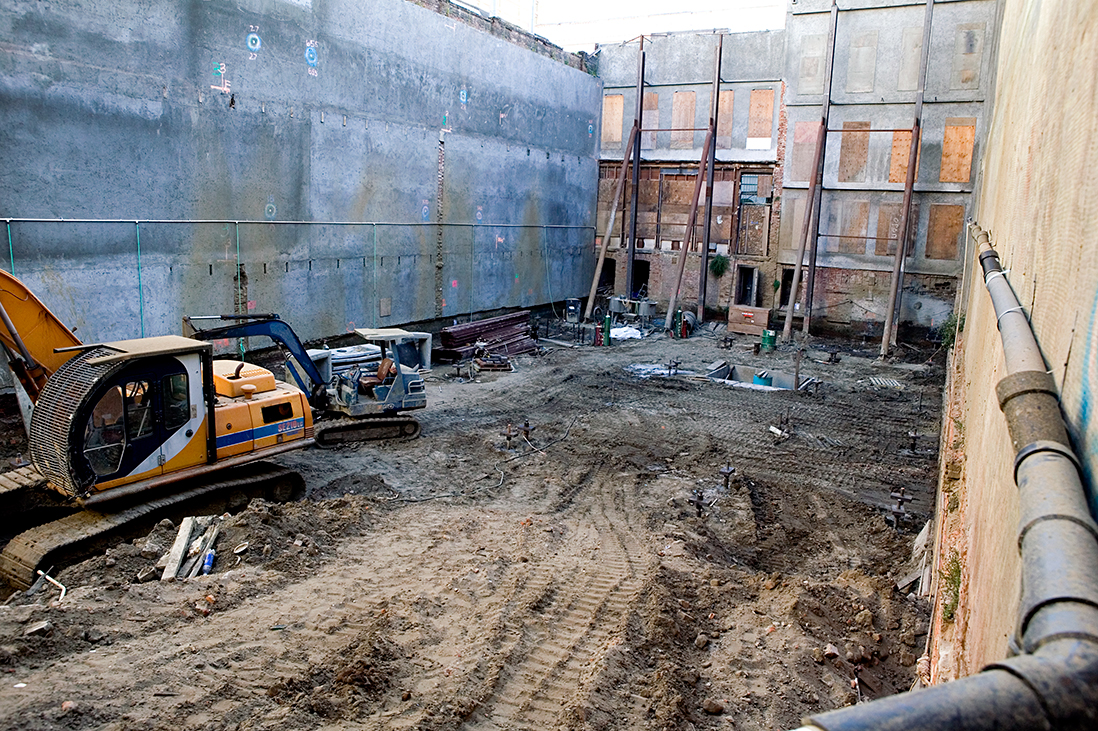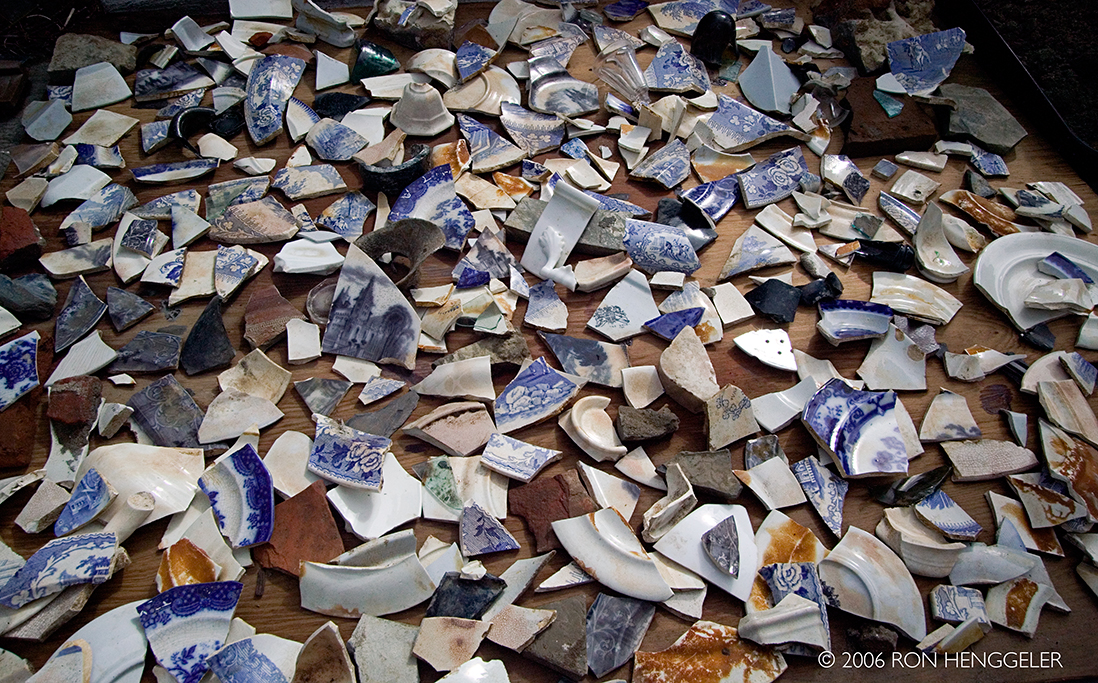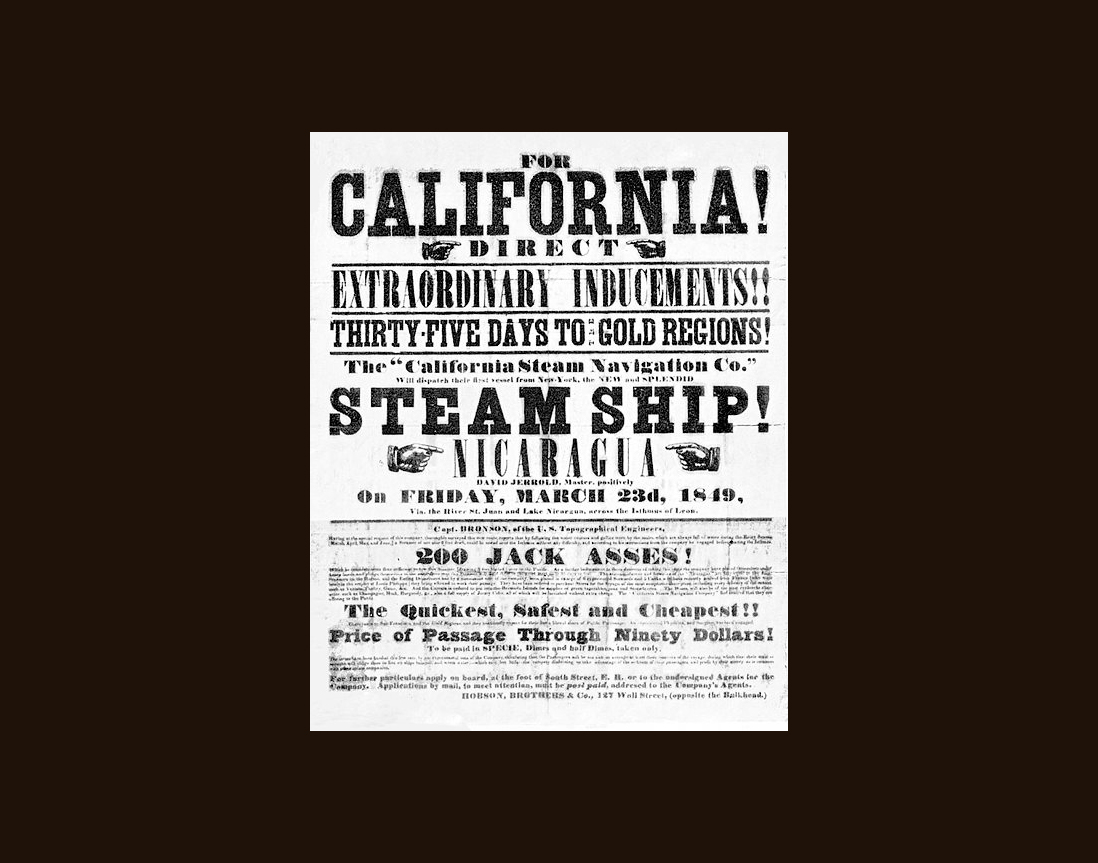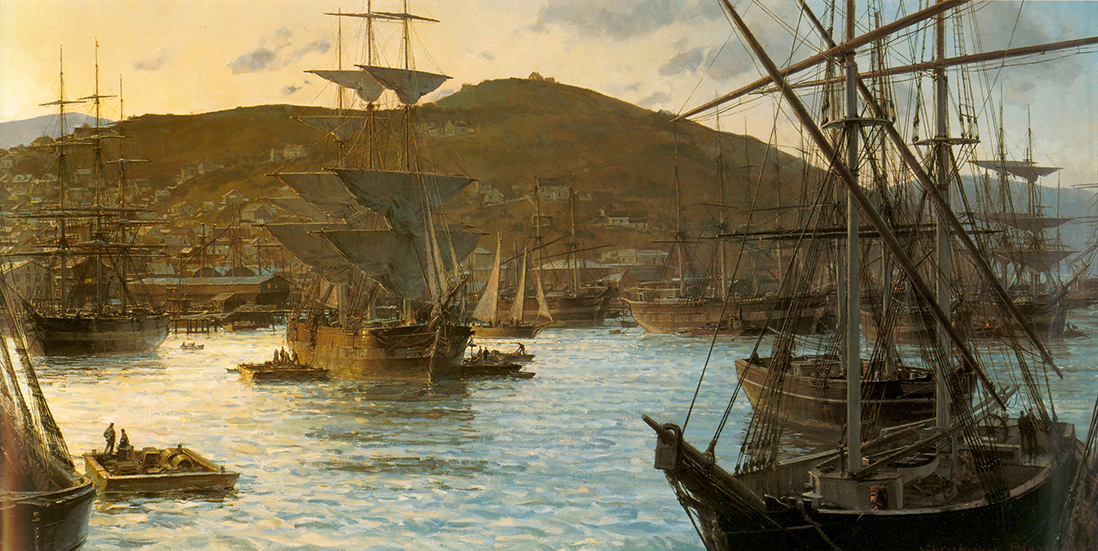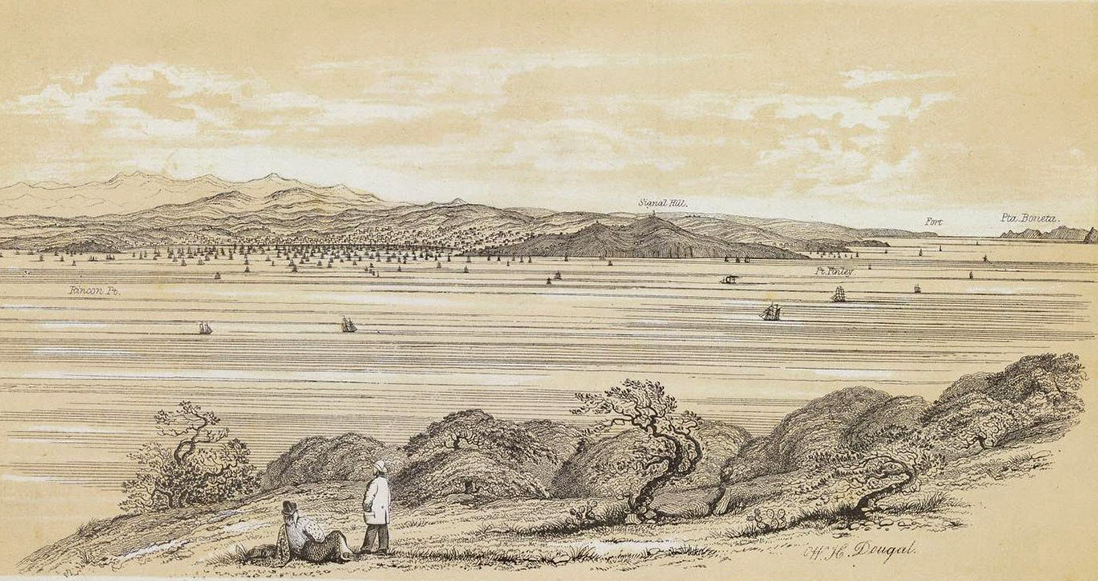RON HENGGELER |
San Francisco during the Gold Rush
On August 5 1775, the Spanish packet San Carlos, under the command of Lieutenant Juan Manuel de Ayala, became the first ship to enter San Francisco Bay. If it wasn't fogged in, this is the view of the 'Golden Gate' entrance to San Francisco Bay, that gold seekers during the 1849 Gold Rush would have seen aboard ship, when entering San Francisco Bay for the first time after their arduous months-long journey to California. |
The first known image of what will later become the city of San Francisco. The watercolor sketch was done in 1837 by Jean Jacques Vioget who was aboard his ship in San Francisco Bay. When he arrived in San Francisco, then known as Yerba Buena, in 1837, only two homes stood in the village on the shore. The watercolor hung in the cabin of his ship for the next two years. Jean Jacques Vioget, originally from Switzerland, was a surveyor and sea captain when he came to California in 1837. He made the first survey and map of Yerba Buena in 1839. He worked for John Sutter and later moved to San Jose.
|
A lithograph by Edward Bonqui depicting San Francisco in 1847. Today the Transamerica Pyramid stands on the original shoreline of San Francisco Bay at Montgomery Street between Clay and Washington Streets. |
A map of the village of Yerba Buena. Yerba Buena was the original name of the Spanish settlement that would later become San Francisco.The settlement was arranged in the Spanish style around a plaza that remains as the present day Portsmouth Square in San Francisco's Chinatown. |
A view of San Francisco prior to the California Gold Rush as seen from around Clark's Point (today's Broadway Street near the Embarcadero). |
"The bay of San Francisco has been celebrated from the time of its first discovery as one of the finest in the world. It rises into an importance far above that of a mere harbor. . . Its latitude position is that of Lisbon, Its climate that of Southern Italy, settlements attest to its healthfulness, bold shores and mountains give it grandeur, the extent and fertility of its dependent country give it great resources for agriculture, commerce, and population. . . To this gate I gave the name Chrysopylae or Golden Gate... “ John Fremont |
San Francisco 1848 by Dorthy Spangler This painting depicts the village of San Francisco as seen from Ricon Hill on the south end of Yerba Buena Cove. The painting was part of a collection of art works that were commissioned in 1969 as part of the celebration of the Southern Pacific Gold Spike Centennial. The entire collection became know as the Gold Spike Album and was first exhibited in the rotunda of San Francisco City Hall. |
A map of San Francisco in 1851 showing the original shoreline of San Francisco Bay. The entire present day Financial District resides on landfill going back to the California Rush days. The darker lines on this map that extend out into the water depict wharfs the were built out to the deeper waters during the Gold Rush in order for goods and supplies to be offloaded from the ships. All the streets in the Financial District running east to west began as wharfs. Broadway, Pacific, Jackson, Washington, Clay, Commercial, Sacramento, California, and Market. The shadowed area is roughly the outline of Yerba Buena Cove when the city was founded and there are more than 40 old wooden ships buried in the old cove that is now part of the city. |
This is my photo of the Transamerica Pyramid taken from atop Telegraph Hill on Union Street where Montgomery Street dead-ends. In this photo, by looking up Montgomery Street, one is looking along the original shoreline of Yerba Buena Cove in San Francisco Bay. |
A sketch of San Francisco by an unknown artist. The lone wharf in the drawing is the Long Wharf or Commercial Street. The single ship on the shore is the Boston whaler Niantic. I've placed my Transamerica Pyramid at this location because in 1978, when excavating the ground next to the Pyramid in preparation for the construction of a high-rise, the buried hull of the Niantic was discovered. |
Another view of the original shoreline of Yerba Buena Cove, taken from the same spot where I shot my Transamerica Pyramid photo. This photo was taken by an unknown photographer in April 1906, who captured one terrible moment in many, of the City burning during the three-day firestorm that destroyed 28,000 buildings and left a quarter of a million people homeless. |
Yet another view looking along the original shoreline of Yerba Buena Cove in San Francisco Bay, and again, this photo is taken in 1921 from atop Telegraph Hill at the same location where I shot my photo of the Transamerica Pyramid. |
On January 24, 1848, James W. Marshall was building a sawmill for Captain John Sutter, using water from the South Fork of the American River. He noticed several flakes of metal in the tailrace water and recognized them to be gold. Though he tried to keep it a secret, the word spread quickly, and triggered the California Gold Rush of 1849. |
The discovery of gold nuggets in the Sacramento Valley in early 1848 sparked the Gold Rush, arguably one of the most significant events to shape American history during the first half of the 19th century. As news spread of the discovery, thousands of prospective gold miners traveled by sea or over land to San Francisco and the surrounding area; by the end of 1849, the non-native population of the California territory was some 100,000 (compared with the pre-1848 figure of less than 1,000). |
Throughout 1849, people around the United States (mostly men) borrowed money, mortgaged their property or spent their life savings to make the arduous journey to California. In pursuit of the kind of wealth they had never dreamed of, they left their families and hometowns; in turn, women left behind took on new responsibilities such as running farms or businesses and caring for their children alone. |
Thousands of would-be gold miners, known as ’49ers, traveled overland across the mountains or by sea, sailing to Panama or even around Cape Horn, the southernmost point of South America. |
|
Mountain Jack and a Wandering Miner, 1850 Oil on canvas painted by E. Hall Martin from the collection at the Oakland Museum of California |
By the end of the 1849, the non-native population of California was estimated at 100,000, (as compared with 20,000 at the end of 1848 and around 800 in March 1848). There were only about 200 people living in San Francisco in 1846-47 prior to the discovery of gold. |
In the middle of the 19th century, the popular phrase "I have seen the elephant" referred to overcoming the adversities and hardships in one's life. A fable revolved around a farmer who heard that the circus was coming to town. He had never seen an elephant, and headed to town with his produce to see the elephant. On the road, he encountered the elephant. Unfortunately, the farmer's horse had never seen an elephant, either. The horse spooked, upset the cart, and ran off, destroying the farmer's produce. Even so, the farmer declared "I don't care, for I have seen the elephant." Most immigrants rushing to California by land or by sea had seen the elephant, "from the tip of his trunk to the end of his tail" by the time they arrived in California. For any who hadn't, two or three weeks in California were certain to bring on the vision. For more, visit: |
A Currier and Ives lithograph print of San Francisco at the beginning of the Gold Rush. The view is from Telegraph Hill, the wharf is Long Wharf, or Commercial Street, and three recognizable ships are the Niantic, the Apollo, and the General Harrison. |
View of San Francisco in 1850 Oil on canvas, painted by George Henry Burgess From the collection at the Oakland Museum of California James Flood, who lived in a splendid mansion high atop Nob Hill (renovated after the fire in 1906 and now the home of the Pacific Union Club) commissioned this work from the artist in 1878. It remains an important record of San Francisco's early days. Burgess was paid $650 for the painting and an additional $100 for the frame. (from: Art of the Gold Rush, by Driesbach, Jones, and Holland, page 54, published 1998) |
San Francisco in July, 1849 Oil on canvas, painted by George Henry Burgess This painting would become the culminating experience of the artist's professional life. Sometime after 1851, Burgess himself prophesied: "That this picture is destined to reach the highest value, which any painting could have for this city or state, is evident. It is the infant village put before us, from which our great city has emerged." (from: Art of the Gold Rush, by Driesbach, Jones, and Holland, page 54, published 1998)
|
This is my photograph of a detail from the painting at the Oakland Museum of California: San Francisco in July, 1849 Oil on canvas, painted by George Henry Burgess From the collection at the Oakland Museum of California |
San Francisco, 1850 Pencil on paper Drawn by John Woodhouse The view is seen from somewhere on the slope of Nob Hill. |
The population of San Francisco exploded from 1848 to 1850. Miners lived in tents, wood shanties, or deck cabins removed from abandoned ships.To meet the demands of the arrivals, ships bearing goods from around the world came to San Francisco. Ships' captains lost their crews who upon arrival quickly deserted to go to the gold fields. The wharves and docks of San Francisco became a forest of masts, as hundreds of ships were abandoned. Enterprising San Franciscans turned the abandoned ships into warehouses, stores, taverns, hotels, and one into a jail. Many of these ships were burned in fires, or they used for to create more buildable land in the boomtown. |
A view of boom-town San Francisco with the hundreds of abandoned ships and the forest of masts as viewed from the slope of Nob Hill. Yerba Buena Island is central in the distance and Telegraph Hill is on the far left of the frame. |
With ships, merchandise and equipment, and thousands of sea-route argonauts pouring into California through the Golden Gate, San Francisco instantly became the hub of the gold rush. No city grew bigger or faster, or with more hustle and bustle. Its population in January 1848 was 800; by 1853 it had mushroomed to over 50,000, with tens of thousands more passing through to and from the mines each year. For a larger version see of this image: |
The wharves that ran east into the deeper waters of Gold Rush San Francisco's Yerba Buena Cove are now the streets running through the Financial District to the Embarcadero which borders the waterfront. |
Here is a view of San Francisco's Portsmouth Square in 1851during the Gold Rush. Today's Chinatown Hilton Hotel on Kearny Street is located at the place where the white building stands in the center of the image. |
Another view of Portsmouth Square in 1851with Washington Street in tfront of the buildings and Telegraph Hill in the distance. |
This is my photograph of a detail from the painting at the Oakland Museum of California: San Francisco in July, 1849 Oil on canvas, painted by George Henry Burgess From the collection at the Oakland Museum of California |
Vista de San Francisco, 1850 Oil on paper Painted by Augusto Ferran From the collection at the Bancroft Library This is a view of Yerba Buena Cove and the distant San Francisco during the Gold Rush as seen from Rincon Hill (where today's Bay Bridge leaves San Francisco for Oakland and the East Bay). On the far left, where ships are beached, is Happy Valley. |
Delegates debated the rights of citizens--even who had a right to be a citizen. Although the Constitution was a bilingual document, the rights of the Californios, and most other people of color in California were severely compromised. California's native people were accorded no rights at all, and were the target of many discriminatory laws and violent attacks. Even after the Constitution established a formal code of laws, disorder and dishonesty reigned. Groups of citizens in San Francisco organized in Committees of Vigilance to enforce their own interpretation of law, order, and justice. |
The famous 'Forest of Masts', with Telegraph Hill in the background. |
My photograph of a detail from: Panorama of San Francisco in 1851, from Nob Hill Acrylic on panel 2009-10 by Frank Alan Zimmerman |
The Great San Francisco Fire of 1851 Around 11 pm on the night of May 3, 1851, a fire (possibly arson) broke out in a paint and upholstery store above a hotel on the south side of Portsmouth Square in San Francisco. Fueled by increasingly high winds, the fire was initially carried down Kearny St. and then, as the winds shifted to the south, into the downtown area, where the elevated wood-plank sidewalks provided extra fuel. The fire, which was visible for miles out to sea, continued for about 10 hours and eventually extended to at least 18 blocks of the main business district, an area three-quarters of a mile long by a third of a mile wide.Before it was checked by reaching the waterfront, it burned down some 2000 buildings altogether, amounting by some estimates to three-quarters of the city. One 19th century account of the destruction observes: "Nothing remained of the city but the sparsely settled outskirts."The total damage has been estimated at around $10–12 million, a good deal of it uninsured as no insurance companies had yet been established in the city. |
My photograph of a detail from: Portsmouth Square in the Spring of 1851 Acrylic on panel 2010 by Frank Alan Zimmerman |
'I have seen the elephant' is a expression denoting world-weary experience. It is an Americanism dating to the early 19th century. The elephant is metaphorical, standing it for the exotic and strange things one sees when one has experience and has seen the world. |
Denim Like many merchants during the Gold Rush, Levi Strauss journeyed to San Francisco to sell goods to the prospectors. An immigrant from Germany, he brought a load of canvas to turn into tents. Strauss had no success selling the tents, but constantly heard miners complain that their pants didn’t hold up to the rigors of the gold mines. He turned the canvas into pants instead, and the garments were an instant hit. He eventually switched from canvas to a tough blue cotton fabric loomed in Nimes, France, called serge de Nimes, which quickly became the word “denim” and gave the trousers their trademark color. The name “jeans” came from the French word Genes (meaning “Genoa”), as the trousers were reminiscent of those once worn by Genoan sailors. The copper rivets, originally designed for saddles, were added to reinforce the pants in the 1870’s and emblazoned with the initials SF for San Francisco. Levi jeans became part of the popular culture during the 1950’s, and business more than doubled in the 1960s. The company is still in San Francisco and is operated by descendants of Levi Strauss. Respectfully taken from SAN FRANCISCO SECRETS by John Snyder 1999 Chronicle Books
|
I fell in love with the most cordial and sociable city in the Union. After the sagebrush and alkali deserts of Washoe, San Francisco was paradise to me. Mark Twain |
Fire in San Francisco Bay, 1856 Oil on canvas, by Charles Christian Nahl and Hugo Wilhelm Nahl The depicted incident occurred on May 24,1853 when two abandoned vessels converted to use as storage ships, the Canonicus and the Manco, caught fire in San Francisco harbor near the end of the Sacramento Street Wharf. The primary factual sources of imagery in the painting were derived from a sketch drawn on the top of a box by a grocer's delivery boy who had witnessed the conflagration. (from: Art of the Gold Rush, by Driesbach, Jones, and Holland, page 54, published 1998) |
This is my photograph of a detail from the painting at the Oakland Museum of California: San Francisco in July, 1849 Oil on canvas, painted by George Henry Burgess From the collection at the Oakland Museum of California |
A view of San Francisco as seen from Folsom and 2nd Streest south of Market Street. The large building in the the very center is Old Saint Mary's Church on California Street at Grant Avenue. |
Forty-niners rushed to California with visions of gilded promise, but they discovered a harsh reality. Life in the gold fields exposed the miner to loneliness and homesickness, isolation and physical danger, bad food and illness, and even death. More than anything, mining was hard work. Fortune might be right around the corner, but so too was failure. The promises and commitments to remain faithful in body and spirit to families left behind were constantly tested by the struggles and temptations of the moment. |
A wonderfully illustrated and informative book about San Francisco during the heady days of the California Gold Rush is titled: When the Water Came Up to Montgomery Street The book is by Charles Fracchia and was published in 2009 |
From 1849 to 1851, San Francisco burned five times In the three year period at the height of the Gold Rush. |
San Francisco after Fire, 1851 Warwercolor on paper painted by John Prendergast From the collection at the Oakland Museum of California |
Those who followed their dreams to the bottom of a stream in the Sierras found themselves confronted with hard work, harsh weather, and a rapidly diminishing supply of gold. The efforts, tools and equipment required to get at the gold which remained quickly became more elaborate. |
These mining scenes reflect the diversity of the people who sought their fortunes in the gold fields of California. They also depict the variety of tools and techniques used in the first months and years of prospecting. There is a Chinese mining camp, an arrastra being worked by a Sonoran, a Miwok woman washing gold with a basket, a pair of miners working a coyote hole, and miners working a long tom, who have been visited by a woman selling pies. As California flooded with people from around the world, the easy surface gold was quickly skimmed. |
My photograph of a detail from: Panorama of San Francisco in 1851, from Nob Hill Acrylic on panel 2009-10 by Frank Alan Zimmerman |
This is a print showing the Niantic Hotel in San Francisco, California in 1850. The Niantic was a ship built in Connecticut in 1832 and was used for whaling. It brought a load of passengers from Panama to San Francisco in 1849 and was abandoned there after all of the passengers and most of the officers and crew left ship and headed to gold country to seek their fortune. The ship was sold and used to house businesses on the waterfront. The quote below explains what happened next: “The front of the city is extending rapidly into the sea, as water-lots are filled up with the sand-hills which the steam excavators remove. This has left many of the old ships, that a year ago were beached as storehouses, in a curious position …. so that a stranger puzzles himself for some time to ascertain how the “Apollo” and “Niantic” became perched in the middle of a street…. “ From: http://picturethis.museumca.org/pictures/san-francisco-1850-niantic-hotel |
The stern of the Niantic is on permanent display in the lobby of the San Francisco Maritime Museum. The buried hull of the Niantic was discovered in 1978 at a construction site next to the Transamerica Pyramid on Clay Street near Montgomery. In San Francisco harbor, most of the crew deserted to join the gold rush. Niantic's log records that five of the crew deserted the first day, nine the second day, three more deserted the fourth day and two were arrested by the US Sloop of War USS Warren for assaulting Captain Cleaveland with a knife, and five were released the sixth day (including one released by Warren). This may have left a crew as small as five to finish unloading the ship. Niantic's log ends the next day, 12 July 1849. Without a crew to sail, and with more ships arriving daily, Niantic's officers were instructed by her owners, probably through an agent in San Francisco, to sell the vessel. With the aid of her empty whale oil barrels tied to her hull for extra buoyancy, the ship was floated on a high tide into shallow water, just offshore from the intersection of Clay and Montgomery Streets. Now hard aground, Niantic was converted for use variously as a warehouse, store, offices, and hotel. |
An end view of the Niantic's stern on display at the Maritime Museum in San Francisco.The Niantic was a whaleship that brought fortune-seekers to Yerba Buena during the California Gold Rush of 1849. Run aground and converted into a storeship and hotel, she was a prominent landmark in the booming city for several years. |
A model of the beached Niantic converted into a store ship as she would have appeared on the San Francisco waterfront during the Gold Rush. This model is on display next to the stern of the Niantic at the Maritime Museum in San Francisco. |
The display at the Maritime Museum includes the ship's log kept by First Mate James Cleaveland, recording the arrival in San Francisco. This diorama shows the ship as she is believed to have appeared in 1850, converted to a storeship but not yet landlocked. |
Here's another depiction of the Niantic, appearing in the center of the image with the large American flag atop the building that was added on to her hull. |
|
San Francisco in July, 1849 Oil on canvas, painted by George Henry Burgess From the collection at the Oakland Museum of California |
Abandoned ships and the forest of masts as seen from the south end of Yerba Buena Cove. During the height of the gold excitement, there were at least five hundred ships stranded in the harbor, some without even a watchman on board, and none with a crew sufficiently large to work her. Many of these vessels never sailed again. Some rotted away and sank at their moorings. (Herbert Asbury in "The Barbary Coast") |
My photograph of : The Steamship Antelope Departing San Francisco, March 1851 Acrylic on panel 2010 by Frank Alan Zimmerman |
|
Isadore Boudin came to San Francisco in 1849 and four years later he opened the bakery where he produced his famous sourdough bread. Sourdough was invented by the Egyptians more than 4,000 years ago, but the white, crusty, slightly bitter, no yeast loaf has become synonymous with San Francisco. There is no doubt that sourdough bread made in the city has a different taste than sourdough bread made anywhere else. Many aficionados assert that the unique , tangy flavor of the local bread can be attributed to the spores, fungi, and bacteria in the San Francisco air. Others claim the special taste of the bread is the result of the fog. Sourdough was a staple food in the Gold Rush days. Miners took sour starters with them on their travels to the extent that those who participated in the Alaska gold rush of the 1890s were called “sourdoughs”. The Boudin Sourdough Bakery is still producing loaves of the popular bread. Respectfully taken from SAN FRANCISCO SECRETS by John Snyder 1999 Chronicle Books
|
Collage depicting ships piled into Yerba Buena cove by Satty, from "Visions of Frisco" edited by Walter Medeiros, Regent Press 2007 |
|
This is my photograph of a detail from the painting at the Oakland Museum of California: San Francisco in July, 1849 Oil on canvas, painted by George Henry Burgess From the collection at the Oakland Museum of California |
This is my photograph of a detail from the painting at the Oakland Museum of California: San Francisco in July, 1849 Oil on canvas, painted by George Henry Burgess From the collection at the Oakland Museum of California |
Charles Christian Nahl (1818-1878), Sunday Morning in the Mines, 1872, oil on canvas. Crocker Art Museum, Sacramento, California, E.B. Crocker Collection |
150 years after it was buried, the Gold Rush ship General Harrison was unearthed in September 2001 at Clay and Battery Streets in San Francisco's Financial District. The General Harrison sailed around Cape Horn to San Francisco. Its passengers and crew, struck with gold fever, deserted the ship right away, leaving it to deteriorate with hundreds of other ships bobbing in the bay. The General Harrison, advertised as a "fine and commodious" storage facility in the Alta California newspaper on May 30, 1850, but it burned to the water line in the first Great Fire, on May 4, 1851. It was salvaged and most of its copper and brass fittings were picked off. Then the hull was buried and not seen again until 2001. |
My photograph of : The Steamship Antelope Departing San Francisco, March 1851 Acrylic on panel 2010 by Frank Alan Zimmerman |
Brass plaques in the sidewalk on the Embarcadero near Levi Plaza and Fog City Diner. |
|
View of San Francisco in 1850 Oil on canvas 41 x 72 inches by George Henry Burgess The panoramic View of San Francisco in 1850 looks east from the Clay Street hill. This view extends toward Portsmouth Square (the old Grand Plaza), which at the time was only a block away from the waterfront. |
The hull of the Candace, an 1818 three-masted bark, dug up at Spear and Folsom Streets on January 2006. For more on the Candace: http://www.sfgate.com/news/article/Experts-dig-up-nautical-past-of-long-buried-1818-2542839.php |
The map showing the hulls of abandoned ships in today's San Francisco complied by Ron Filion. |
|
In 2006, the historic Belli Building was torn down. It stood for 145 years in the very heart of San Francisco, a block away from the eastern edge of today's Chinatown, and shadowed from the sun by the tall Transamerica Pyramid. It was originally built as a tobacco warehouse, but it soon became the Melodeon Theatre. Dancer, singer, and actress Lotta Crabtree, California's first child star, performed here. Years later, when she had become a national celebrity, she gave San Francisco our beloved Lotta's Fountain, at 3rd and Market. The city's first Masonic Lodge was organized in the building. Oscar Wilde, on a stop in San Francisco during his nationwide tour, visited a friend in one of the apartments on the upper floor. Bret Harte wrote 'The Luck Of Roaring Camp' while he was living here. In the 1960's the building and the Genella Building next door became the offices of the world-renowned attorney Melvin Belli. He owned the building for several decades. During his time in the building, evidence of its location on the original shoreline could be seen from the rise and fall of tidal waters in the elevator shaft. |
A photo of a few of the artifacts that I found at the Belli Building site after it was demolished. For more of the story: |
|
|
Yerba Buena Cove 1850 |
|
The distant Gold Rush San Francisco as seen from Yerba Buena Island. |

The distant San Francisco as seen today from Yerba Buena Island.
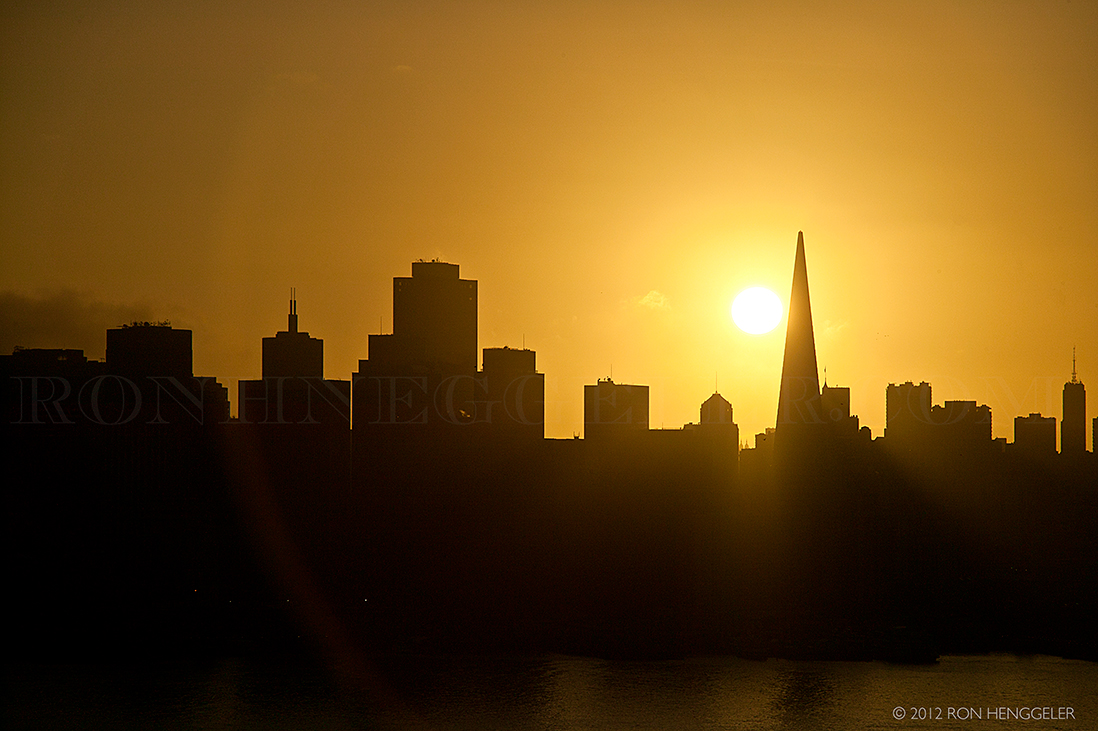
The distant San Francisco as seen today from Yerba Buena Island.
"To this day the city of San Francisco remains to the Chinese the Great City of the Golden Mountains."
Kai Fu Shah, Chinese Minister to U.S. 1914

“....this marvelous city. Bazaar of all the nations of the globe, (compares) with the fantastic creations of ‘The Thousand and One Nights’ ”
Edmond Auger, French gold hunter seeing San Francisco in 1849
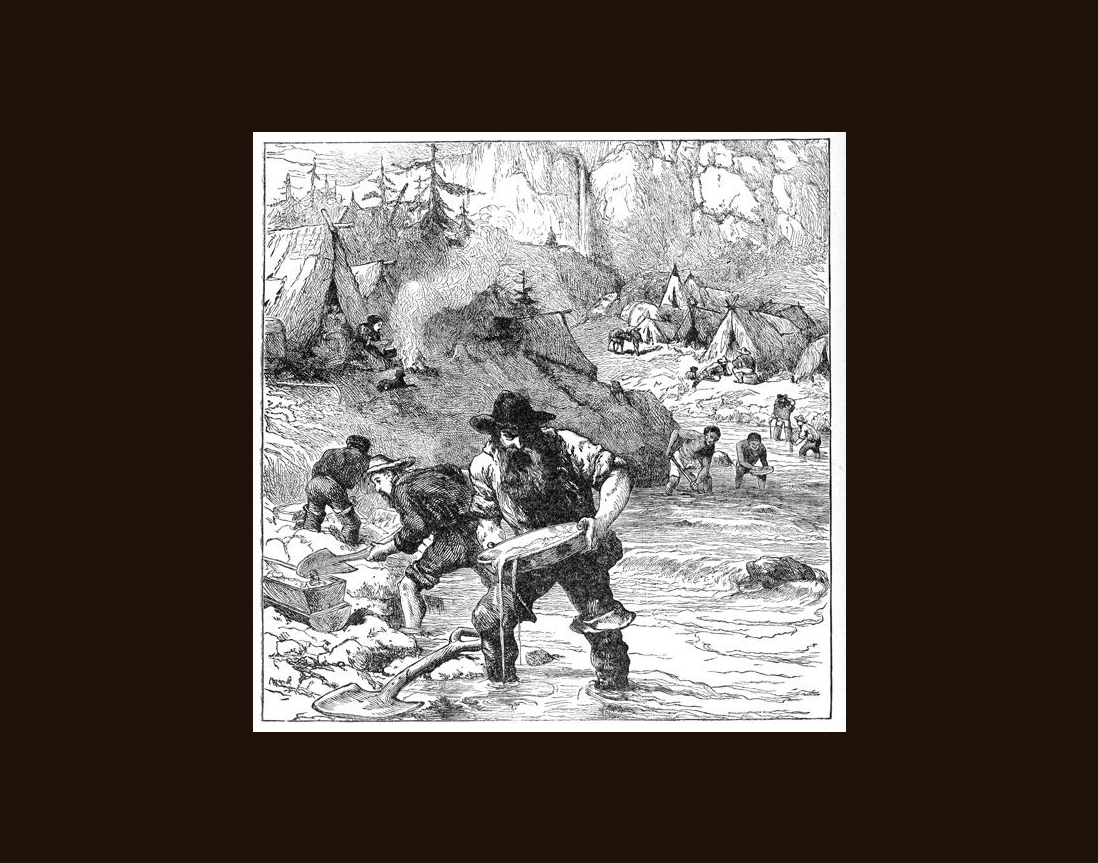
Newsletters Index: 2017, 2016, 2015, 2014, 2013, 2012, 2011, 2010, 2009, 2008, 2007, 2006
Photography Index | Graphics Index | History Index
Home | Gallery | About Me | Links | Contact
© 2017 All rights reserved
The images are not in the public domain. They are the sole property of the
artist and may not be reproduced on the Internet, sold, altered, enhanced,
modified by artificial, digital or computer imaging or in any other form
without the express written permission of the artist. Non-watermarked copies of photographs on this site can be purchased by contacting Ron.
